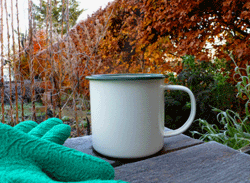 Garden: mainly vegetable plot with flowers interspersed, single ornamental flower border, more flowers and herbs tucked into corners, small lawn.
Garden: mainly vegetable plot with flowers interspersed, single ornamental flower border, more flowers and herbs tucked into corners, small lawn.
Site: on edge of farmland, fertile clay soil, prone to winter waterlogging.
Bordered by: mixed farm hedge/ picket fence/ beech hedge/outbuildings & wide gateway.
Also: Sizeable Patio: sheltered, with ornamentals, herbs and salads
Apologies for the three month gap: as usual I seem to lose the plot blog-wise over the summer. Once again the days flew by and before you know it it’s all over bar the shouting, as my mum used to say.
I have been on twitter though: having resisted for years, I joined in February and discovered it’s great fun. Do follow me if you’re a tweeter too:
www.twitter.com/mrssimkinscooks
Here’s a mini-gallery of the highlights in the garden.
Raised Salad Bed
One of the big successes of 2017 was the new raised salad bed. All went well but next year will forget my fluffy ideas of nasturtiums round the edge: they were far too boisterous and took over eveything like some kind of ever encroaching jungle.
Mind you, they were the best, healthiest and most floriferous nasturtiums I’ve ever grown! Will restrict myself to just a few mini pot marigolds next year.
Also, I’ll sow lettuce seeds more thinly and more often.
Here I am getting the bed ready at the startand demonstrating the ‘gardener’s shuffle’
It was brilliant popping into the garden to pick lettuce for salads every day and for my favourite Marmite and lettuce sandwiches. (Lovely fresh brown seedy bread, lightly buttered, thinly spread with Marmite on one piece, top with lettuce.)
I’m wondering about having another smaller bed over on the other side of the garden for a few carrots, beetroot and salad onions next year.
Mange Tout 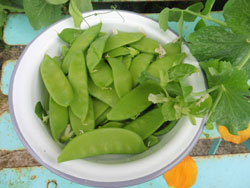
An early success was a small crop of mange tout from the patio in late May and early June.
The plants I bought on a whim in Lidl a couple of months earlier really came through.
Will look out for some next year.
Amazingly, had 3 or 4 pickings from these, each giving 4 servings
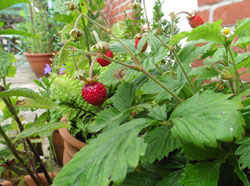
Alpine Strawberries
Alpine Strawberries have been brilliant: I’ve got plants popping up everywhere now, on the patio and in the garden.
I can’t say I harvest bucket-loads at a time but it’s lovely to wander round in the sunshine popping a few of the intensely, almost wine-like, flavoured berries into your mouth or collecting a handful for the kitchen.
Love them scattered over cereal or porridge or over salads.
Runner Beans
I only grew a single wigwam of runners this year as they tend to run away with themselves just as we’re off on holiday but I do love them when they are still small-ish.
They almost got blown over by summer winds: the leaning tower of beans!
I do have some fab recipes I must share with you though at some point: runner bean fritters, runner beans in tarragon cream and a fab curry.
And of course, you can always dry them as kidney beans. Look out for special varieties for drying.
Tomatoes
We’re not big tomato eaters in our house, my daughter and I like home grown ones if they are only just ripe and not at all squishy or deep red. We always grow a few Gardener’s Delight but blight often sets in by August.
The first tomatoes in July were great but then blight seemed to strike
mid-August. I cut off all the leaves and some of the branches. We even
took a couple branches on holiday to ripen ‘on the vine’ and it worked
quite well.
I never had blight at all where we lived before. This must be a 'blighty' area. Strange, grew exactly the same variety using exactly the same culture methods.
Oddly, when we came home the plants seemed to have recovered a bit and had some new green leaves. A few nice tomatoes but now starting to split because of uneven watering! Typical!
Holiday Care
Speaking of cutting down, before we went away, I cut down lots of our plants on the patio: soft herbs such as mint and parsley, all my lovely violas and pansies and a few other repeat ‘flowerers’. This worked well overall, the herbs responded particularly well, not sure about the violas though; I think they had probably just about come to the end of their strength. There are a few seedlings popping up from the seed heads that got away so we’ll have to see.
Pansies & Violas
Pansies & Violas on the patio have been fabulous this year putting on a summer-long show. Purely I think because I smothered them with love: kept on top of watering, fed them with a slow release fertiliser and, crucially, dead-headed them every day.
I started off the year with some lovely purple winter pansies and then bought loads of violas in the spring: I had them popping up everywhere and all did well: these delicate lilac and white ones were probably the best performers of all: they even looked good from the back through our kitchen window!
Finally
Elsewhere in the garden, borage and evening primroses are now well established, as is perky erigeron, softening edges all over the place.
I still haven’t got many opium poppies or foxgloves though which I would love to have. This unexpected poppy by next door’s bonfire site made me smile!
Also fabulous, some mystery marigolds given by a friend and my gorgeous Zinnias: my first ever year of Zinnia success!
And, the Weirdest Garden Discovery of the Year Award goes to:
Lycogala epidendrum aka pink slime mould/wolf's milk slime
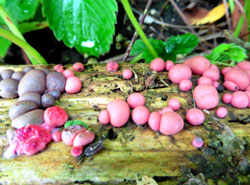 Just look at this! It appeared on some sadly rotting wood edging. My first thought was: “Who’s been leaving bubblegum in my garden!”
Just look at this! It appeared on some sadly rotting wood edging. My first thought was: “Who’s been leaving bubblegum in my garden!”
It doesn’t stay that lovely colour though, a couple of days later it had calmed down into a kind of pale mushroom-y beige.
Still can't work out why it's called wolf's milk slime though. Doesn't look like milk, doesn't even look like slime!
The main garden is still very wet and muddy and not much can be done there at the moment, so thank goodness for the patio and for pots of cheerful colour by the back door.
Primulas, grape hyacinth, mini daffodils, all looking good.
Nice haphazard arrangement of pots there!
Fritillaries working well with grape hyacinths. Winter pansies and violas are blooming beautifully too and I’ve even got a couple of crocuses on the go.
Years ago, in our old garden, I once planted 200 crocus bulbs along a little path. I went to bed that night dreaming of tripping happily down the path in the spring and seeing them all lifting up their little faces to the sun.
Unfortunately, it was not to be. All the bulbs were dug up and eaten by mice and voles. About 2 came up. I’ve only ever bought them in pots since.
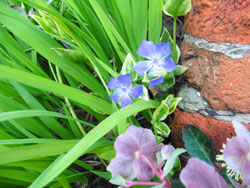
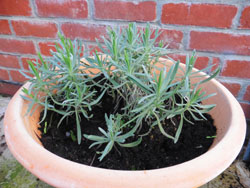
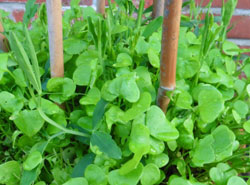
Perennial herbs from last year are coming up nicely again: chives and mint are looking particularly lush and lavender has lasted surprisingly well. The claytonia that self-seeded into the everlasting pea pot is still in fantastic form and has been providing salad pickings since January.
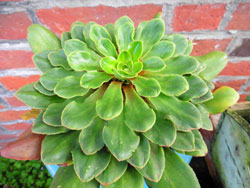 I think I’ve lost my sage and the rosemary isn’t looking too hopeful but I was pleased to have one of my 2 lewisias survive. Thyme is looking serviceable if a bit raggy and I think the marjoram will pull through.
I think I’ve lost my sage and the rosemary isn’t looking too hopeful but I was pleased to have one of my 2 lewisias survive. Thyme is looking serviceable if a bit raggy and I think the marjoram will pull through.
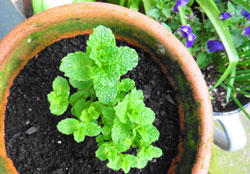 I am feeling very proud of my mangetout seedlings – they’ll need some sticks and netting soon – and I was pleased to see the first couple of periwinkles pop their heads out by the back door a couple of days ago. They look so pretty against the pot of hellebores just in front of them.
I am feeling very proud of my mangetout seedlings – they’ll need some sticks and netting soon – and I was pleased to see the first couple of periwinkles pop their heads out by the back door a couple of days ago. They look so pretty against the pot of hellebores just in front of them.
The Bug Box – Anyone at Home?
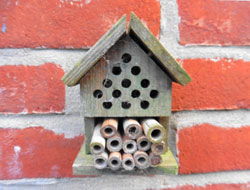 This little bug box needs a good clean out and some serious tlc if it’s going to last another year. Think there are signs of occupancy though: there’s a spider’s nest in the roof and a couple of the bamboo tubes look as though they’ve been sealed up with mud. The box was a present to my son from friend years ago, maybe it’s time to invest in a more ambitious and heavy duty one!
This little bug box needs a good clean out and some serious tlc if it’s going to last another year. Think there are signs of occupancy though: there’s a spider’s nest in the roof and a couple of the bamboo tubes look as though they’ve been sealed up with mud. The box was a present to my son from friend years ago, maybe it’s time to invest in a more ambitious and heavy duty one!
 On 4th November last year we had the most spectacular cloud formations and sunset at around 4 or 5 o’clock. I was desperate to take some photos but was in the car at the time with no camera and the phone I had then wasn’t up to the job. By the time I got home it was nearly half past five and getting dark but I did manage this shot of the clouds stretching up above the farm next door, looking a bit like angel’s wings. Lovely, but you should have seen the the sky earlier!
On 4th November last year we had the most spectacular cloud formations and sunset at around 4 or 5 o’clock. I was desperate to take some photos but was in the car at the time with no camera and the phone I had then wasn’t up to the job. By the time I got home it was nearly half past five and getting dark but I did manage this shot of the clouds stretching up above the farm next door, looking a bit like angel’s wings. Lovely, but you should have seen the the sky earlier!
That was over 2 months ago and I still regret I couldn’t have taken more.
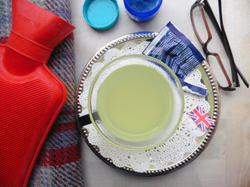 Once again, far too much time has passed since my last blog. Along with much of the country, including the Queen, I’ve been laid low for weeks with a hideous virus or ‘heavy cold’ as the Queen bravely called it. Apparently, it’s an ‘adenovirus’ rather than the more usual ‘rhinovirus’ characterised by a hacking cough and the fact that it hangs around for weeks. Around here, people have taken to calling it the hundred days cough, a term that used to be reserved for whooping cough.
Once again, far too much time has passed since my last blog. Along with much of the country, including the Queen, I’ve been laid low for weeks with a hideous virus or ‘heavy cold’ as the Queen bravely called it. Apparently, it’s an ‘adenovirus’ rather than the more usual ‘rhinovirus’ characterised by a hacking cough and the fact that it hangs around for weeks. Around here, people have taken to calling it the hundred days cough, a term that used to be reserved for whooping cough. 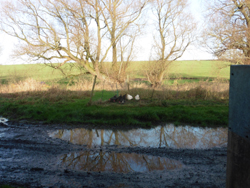 A strain of that, incidentally, was also doing the rounds in our part of the world about 18 months ago.
A strain of that, incidentally, was also doing the rounds in our part of the world about 18 months ago.
There’s not been much action in the garden over the last couple of months. On top of the virus, it’s exceptionally muddy here this winter with much of the ground waterlogged.
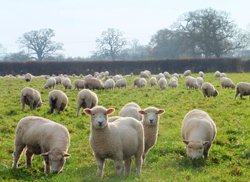 Some sheep arrived in the fields near us just before Christmas: it’s always lovely to see – and hear - them but they can never stay long as the wet ground gets churned up so quickly.
Some sheep arrived in the fields near us just before Christmas: it’s always lovely to see – and hear - them but they can never stay long as the wet ground gets churned up so quickly.
The best I’ve been able to do over in the garden is clear away debris and cover the beds with spent straw from the chicken coop: see the Chicken blog for more details.
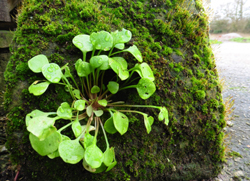 The great gardening success story over the last couple of months has been the claytonia on the patio. Claytonia perfoliata also known as Indian lettuce, spring beauty, winter purslane, or miner's lettuce grows literally like a weed through the cooler months.
The great gardening success story over the last couple of months has been the claytonia on the patio. Claytonia perfoliata also known as Indian lettuce, spring beauty, winter purslane, or miner's lettuce grows literally like a weed through the cooler months.
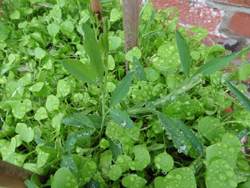 Once you’ve grown it, it will seed itself in the most unlikely places: it prefers cool damp conditions.
Once you’ve grown it, it will seed itself in the most unlikely places: it prefers cool damp conditions.
It’s a hardy annual with slightly succulent leaves shaped a bit like a rounded shield or a wide spoon. As it grows bigger, the leaves become perfoliate which means they wrap round the stem, and a wisp of tiny little white flowers develops inside. 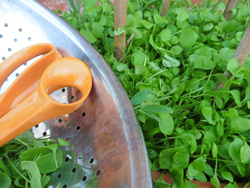 It’s native to North America but now grows all over Western Europe, apparently introduced via Kew Gardens where it arrived in 1794 with the Scottish surgeon, botanist and naturalist Archibald Menzies.
It’s native to North America but now grows all over Western Europe, apparently introduced via Kew Gardens where it arrived in 1794 with the Scottish surgeon, botanist and naturalist Archibald Menzies.
It has a lovely mild flavour and is so useful as a salad leaf, full of vitamin C, and it’s just about the only salad leaf I know that children take to immediately.
 Apparently, it can be cooked like spinach but I have never tried it: I’m too busy wolfing it down as salad!
Apparently, it can be cooked like spinach but I have never tried it: I’m too busy wolfing it down as salad!
Seeds aren’t widely available but you can order them from Chiltern Seeds
www.chilternseeds.co.uk
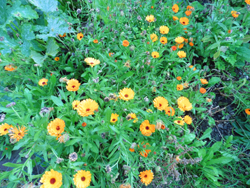 I don’t know what’s happened this year; I have got so behind in the garden: last week I could hardly see any garden at all. Where had it gone? Under a ton of weeds that’s where!
I don’t know what’s happened this year; I have got so behind in the garden: last week I could hardly see any garden at all. Where had it gone? Under a ton of weeds that’s where!
And not only weeds but flowers as well had got completely out of control: both in the border and the vegetable beds. Without singling out too many individuals those known thugs Michaelmas daisies had spread well beyond their intended space and the pot marigolds had practically taken over the last of the courgettes.
I love flowers around the edges of the vegetable beds; they look so pretty and encourage beneficial predators and pollinating insects. Plus some of them are edible and you can pick them for informal cottage-garden arrangements. But you do have to be careful as they can easily take over. Especially if like mine, most of your beds are on the small size in the first place.
 And the moral of the story? Keep on top of your garden before it gets on top of you! Some serious weeding and cutting back needs to take place ASAP.
And the moral of the story? Keep on top of your garden before it gets on top of you! Some serious weeding and cutting back needs to take place ASAP.
Something I’ve noticed over the years: if you can just set aside a few minutes every day to do just a few tasks and notice everything that might be needing attention, is almost ready to harvest and so on, you are halfway to well-maintained garden. I really must get back into this habit; mind you, easier said than done!
Generous Gardener Rose
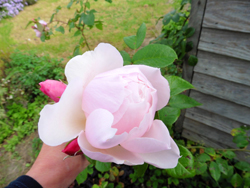 I love this rose, a David Austin climber/rambler; it’s been in the garden for a year now and given us endless pleasure. It’s described in the catalogue as ‘a rose of delicate charm’ and that’s exactly right.
I love this rose, a David Austin climber/rambler; it’s been in the garden for a year now and given us endless pleasure. It’s described in the catalogue as ‘a rose of delicate charm’ and that’s exactly right.
Michaelmas Daisies
So called because they are in bloom around Michaelmas – September 29th – or the Feast of St Michael and Archangels it always lifts my heart and I wouldn’t be without it even if it does take over. My grandmother used to have a whole border of them in her garden and they always remind me of her. My grandfather’s birthday was September 29th and I think of him too.
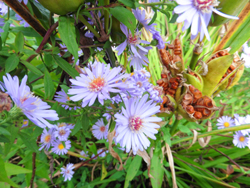 Incidentally, Michaelmas Day is meant to be the day that Lucifer was thrown out of Heaven by the Archangel Michael. Obviously, Lucifer was slightly annoyed by this and the story goes that one of his milder acts of revenge was to spit on all the blackberries and spoil them on this day every year.
Incidentally, Michaelmas Day is meant to be the day that Lucifer was thrown out of Heaven by the Archangel Michael. Obviously, Lucifer was slightly annoyed by this and the story goes that one of his milder acts of revenge was to spit on all the blackberries and spoil them on this day every year.
Yellow Flag or Fleur-de-lys
Iris pseudacorus
Yellow flag is one of our most stately native wild flowers. It loves damp ground and the margins of ponds. Flowering between June and August, in the autumn the seed pods ripen and split into 4 to and exposing the large orangey brown seeds: you can see a split pod to the right of the Michaelmas daisies, above. Our border is quite damp almost all year round and becomes water-logged in winter.
I brought this clump from our previous garden where it just sprang up one year 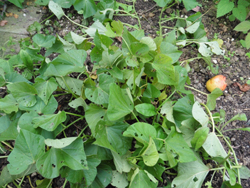 at the back of a raised vegetable bed and it’s slowly increased in size.
at the back of a raised vegetable bed and it’s slowly increased in size.
Sweet Potato
I bought this sweet potato on impulse one morning and hope it’s going to do well. I love sweet potatoes but have never tried to grow one before.
It’s certainly spread but the previously glossy green leaves are now looking a bit worn and battered and something’s been eating the leaves. 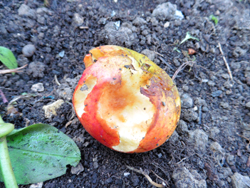 There’s no way of telling what’s going on underneath just yet as harvest isn’t recommended until the leaves have died back after frost.
We had a slight frost on October 3rd but not enough to knock things back.
There’s no way of telling what’s going on underneath just yet as harvest isn’t recommended until the leaves have died back after frost.
We had a slight frost on October 3rd but not enough to knock things back.
Who scrumped the apple?
I’m not sure where this bitten apple came from: the nearest apple trees are a few yards away the other side of a single story building so it’s unlikely to have blown over the roof.
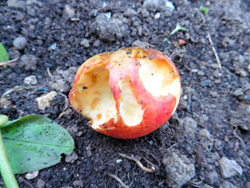
I have seen crows in previous years carrying apples off speared on their beaks so maybe that’s what happened.
Success with Carlin Peas
I was pleased with these carlin peas: I grew them from a packed of dried culinary carlin peas curious to know what would happen. 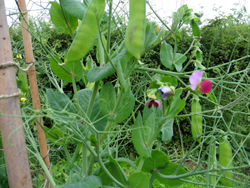 I sowed some ordinary peas (Lincoln, I think) and they disappeared without trace whilst these thrived. I’ve got a small crop from them and will definitely grow them again next year: and the flowers are pretty!
I sowed some ordinary peas (Lincoln, I think) and they disappeared without trace whilst these thrived. I’ve got a small crop from them and will definitely grow them again next year: and the flowers are pretty!
If you’ve never heard of them, here’s a quick run-down.
Carlins or carlings are a tasty old variety of dried pea. Grown in Britain since the Middle Ages, they seem to have inexplicably fallen out of favour in more recent times.  Nevertheless, twice a year, in parts of the North and Midlands they are still popular as traditional ‘parched peas’ on Carlin or Passion Sunday (the 5th Sunday of Lent) and Bonfire Night.
Nevertheless, twice a year, in parts of the North and Midlands they are still popular as traditional ‘parched peas’ on Carlin or Passion Sunday (the 5th Sunday of Lent) and Bonfire Night.
(Also known as pigeon, maple, grey or black peas, or ‘black badgers’ they are not to be confused with the pigeon pea of Asian, African and Latin American cooking.)
Fall Streak Hole or Hole Punch Clouds
 We’ve had some spectacular cloud formations this year: these ones (see below) appeared around 10 o’ clock on the morning of October 10th. I think they are fall streak clouds. Apparently they are semi rare and only last a short time. They form from Cirrus clouds when the ice crystals fall.
We’ve had some spectacular cloud formations this year: these ones (see below) appeared around 10 o’ clock on the morning of October 10th. I think they are fall streak clouds. Apparently they are semi rare and only last a short time. They form from Cirrus clouds when the ice crystals fall.
According to Wikepedia:
 A fallstreak hole (also known as a hole punch cloud, punch hole cloud, skypunch, cloud canal or cloud hole) is a large gap, usually circular or elliptical, that can appear in cirrocumulus or altocumulus clouds. Such holes are formed when the water temperature in the clouds is below freezing but the water, in a supercooled state, has not frozen yet . . . .
A fallstreak hole (also known as a hole punch cloud, punch hole cloud, skypunch, cloud canal or cloud hole) is a large gap, usually circular or elliptical, that can appear in cirrocumulus or altocumulus clouds. Such holes are formed when the water temperature in the clouds is below freezing but the water, in a supercooled state, has not frozen yet . . . .
 You can see Duncliffe Hill in the distance on the left. Duncliffe Hill is one of over 40 hills in Dorset and really stands out for miles around as it’s surrounded by lowland. Near Shaftesbury, in the Blackmore Vale, its flat dome shape is unmistakeable.
You can see Duncliffe Hill in the distance on the left. Duncliffe Hill is one of over 40 hills in Dorset and really stands out for miles around as it’s surrounded by lowland. Near Shaftesbury, in the Blackmore Vale, its flat dome shape is unmistakeable.
In line with my ‘less is more plan’ mentioned back in April, I didn’t exactly intend that to encompass ‘fewer blog posts is more this summer’ as well!  So massive apologies for that, life just takes over sometimes.
So massive apologies for that, life just takes over sometimes.
I did in fact, grow fewer varieties of plant and sow fewer seeds and it turned out to be a good plan. Generally speaking, if you know you are going to be pressed for time later in the season, it’s best to invest your time and energies into just a few must-haves.
When spring is in the air, it’s easy to go mad sowing lots of varieties that you quite fancy, forgetting that later on, just when they need your help to flourish: potting on, thinning, out, protection from pests, feeding, watering etc, your time will be taken up elsewhere.

Plants thrive on care and attention so it pays not to over-burden yourself.
Weather-wise, 2016 hasn’t been the best, off to a very slow start, it’s been wet and windy, with unseasonable late hailstorms and sleet. Perhaps unsurprisingly, the fruit trees around us have smaller crops than usual.
Blue skies and mare’s tail clouds (Cirrus uncinus)
We’ve had some wonderful skies and cloud formations this summer though. Here’s an almost clear blue sky back in June. The thin wispy clouds, as you probably know, are mare’s tails or Cirrus uncinus a type of cirrus cloud.
 Cirrus uncinus, incidentally, means ‘curly hooks’ in Latin.
Cirrus uncinus, incidentally, means ‘curly hooks’ in Latin.
Every year is different
Runner beans were slow to get going this year but are now flourishing. Courgettes haven’t been as prolific as usual but I’ve got some promising pumpkins.
Which is odd as I seem to remember last year, beans started early and finished early, courgettes went mad and pumpkins weren’t good at all!
Alpine Strawberry Fragaria vesca
One of the stars of our garden this year has been the Alpine strawberries. Apparently, some varieties can be bland but I’ve always found them gorgeously sharp yet sweet and aromatic. 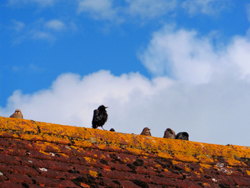 I grew a white variety years ago as well which I’d love to find and grow again. The birds left them alone as they weren’t red so they didn’t notice them. Intriguingly, they tasted more of apple than strawberry.
I grew a white variety years ago as well which I’d love to find and grow again. The birds left them alone as they weren’t red so they didn’t notice them. Intriguingly, they tasted more of apple than strawberry.
It’s well worth letting these gorgeous little fruits establish themselves about the garden: they make terrific ground cover and good borders for larger vegetable beds.
Pretty, productive and tough, you can grow them from seed but the easiest way is to buy half a dozen plants and let them seed themselves about and get on with it. Trim them back when they look a bit tired. The odd dose of liquid seaweed wouldn’t go amiss either
Among other places, I’ve got some growing under a bench: handy for popping straight into your mouth whilst taking a few moments to relax.
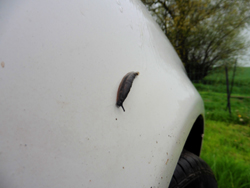 The fastest slug in the West
The fastest slug in the West
Well in Dorset anyway. Back in May I drove the couple of miles to our local town on the school run one morning and back again.
This slug stayed on the car the whole time. Usually a demented slug-slayer I felt the resilient little guy deserved a break so left him to it. He’d gone later.
I don’t know why I said he! Slugs are well known hermaphrodites with both male and female reproductive organs. It still takes two, though. Two slugs get together, exchange sperm and a few days later they both lay a clutch of about 30 fertilised eggs. You will have noticed them under the soil and in plant pots: like tiny little milky white pearls.
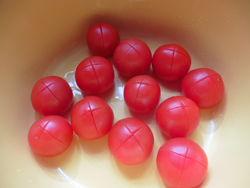
Tomatoes
I stuck with only 3 Gardener’s Delight tomato plants this year as planned, which have produced just the right amount of tomatoes for us, but if you have an end of summer glut here are a couple of quick and easy recipes, the first for standard or ‘slicing’ tomatoes, the second for cherry tomatoes although you can use cut-up slicing ones as well. There’s also a tomato recipe on the cooking blog.
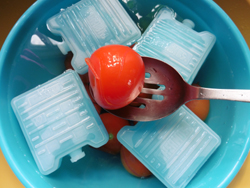 Skin, core and seed tomatoes for chutney
Skin, core and seed tomatoes for chutney
There’s no doubt about it, chutney is so much nicer if you skin, core and seed the tomatoes first: I absolutely adore peeling tomatoes; it’s so therapeutic and very easy. I prefer to do this before using fresh tomatoes for sauces too.
How to Peel and De-Seed Tomatoes
- Cut a cross in the bottom of each tomato.
- Stand tomatoes cross uppermost in a large bowl and cover with boiling water.
 Wait 30 seconds and, using a slotted spoon, transfer to a bowl of cold water containing ice cubes or freezer blocks.
Wait 30 seconds and, using a slotted spoon, transfer to a bowl of cold water containing ice cubes or freezer blocks. - Drain and peel away skin.
-
Cut tomatoes into quarters and remove core with a sharp knife, remove any remaining seeds with a teaspoon.
Quick Tomato Breakfast Relish
This tastes a little like HP sauce with just a little bit of Branston pickle thrown in. Ever so quick to make, once you have your tomatoes prepared, it’s ready within the hour.
It’s the perfect flavour to go with a cooked breakfast: It’s also good with pork pie, cold cuts or cheese. 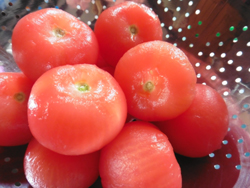 Try with the cheesy tomato scones over on the cooking blog. Don’t leave out the ground cloves: it’s essential for that HP style flavour.
Try with the cheesy tomato scones over on the cooking blog. Don’t leave out the ground cloves: it’s essential for that HP style flavour.
-
1 small onion, finely chopped
- 1 tablespoon rapeseed oil
- ½ red chilli, sliced, seeds discarded or included, according to preference
- 1 clove garlic, finely chopped
- 300g medium-large slicing tomatoes, peeled, cored, de-seeded and chopped (see above)
- 60g golden granulated sugar
- Pinch of ground cloves
-
50ml balsamic vinegar
-
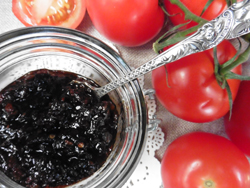 Fry onion slowly over a low heat until soft. Add chilli and garlic for last 5 minutes.
Fry onion slowly over a low heat until soft. Add chilli and garlic for last 5 minutes.
- Add tomatoes, sugar and cloves and stir.
- Stir in vinegar, bring to the boil then reduce heat and cook gently for 30-40 minutes until reduced and jammy.
- Cool, cover and refrigerate.
Eat within 2 weeks.
Oven-Dried Tomatoes
If you love sun-dried tomatoes (and what tomato lover doesn’t?) you’ll want to make these.
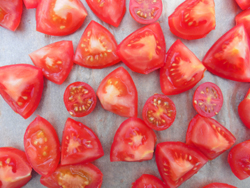 It’s amazingly easy to turn your surplus tomatoes into a luxury product. The hardest part is halving or quartering all the tomatoes. Actually, no. The hardest part is waiting the 2 hours or so for them to come out of the oven.
It’s amazingly easy to turn your surplus tomatoes into a luxury product. The hardest part is halving or quartering all the tomatoes. Actually, no. The hardest part is waiting the 2 hours or so for them to come out of the oven.
You can use as many or as few as you like of any size tomatoes.
Oil – the choice is yours, olive is classic and adds flavour but rapeseed, sunflower or plain old vegetable all work well
Sea salt flakes (optional)
You will need one or more baking trays, lined with lightly oiled baking parchment or greaseproof paper. (Do line the trays; it makes life easier and the tomatoes nicer)
-
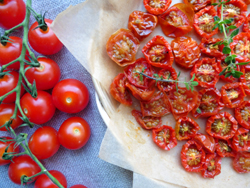 Cut cherry tomatoes in half through the middle – as in through the ‘Equator’. Cut halves of larger ones into 4 equal pieces.
Cut cherry tomatoes in half through the middle – as in through the ‘Equator’. Cut halves of larger ones into 4 equal pieces.
- Arrange tomatoes, seeds uppermost on tray(s).
- Drizzle with oil, scatter lightly with salt if using.
-
Bake at 80C (fan oven) or your oven’s lowest setting for 2 hours or until the tomatoes are shrinking and wrinkled.
Store in a lidded jar or plastic box in the fridge drizzled with a little more oil. (I’ve never been able to store any yet as they all go instantly as soon as they are cool.)
Tip
Add sprigs of rosemary or thyme before drizzling with oil for a herby flavour.
 Cheesy Tomato Scones
Cheesy Tomato Scones
If you nip over to the latest post on the cooking blog, there’s a lovely recipe for cheesy scones using the oven-dried tomatoes. Gorgeous just with a dab of butter they go brilliantly with a bit of cheese and some of the Quick Tomato Breakfast Relish.

 All this unsettled weather doesn’t make it easy to get down to any serious gardening. We must be running about a month behind compared with last year.
All this unsettled weather doesn’t make it easy to get down to any serious gardening. We must be running about a month behind compared with last year.
I never thought I’d be a fair-weather gardener but it is so cold and miserable out on the plot with the wind whipping round, plus all the recent rain means the soil is too wet to be dug over. I’m also keen not to risk sowing too many seeds outside yet to only to keel over and die in the wildly fluctuating temperatures.
Plants do have a way of catching up so it’s probably best just to hang on in there for the moment.
Pinks, violas, herbs, one tomato and knitted cacti
In line with my ‘less is more plan’ I’m hardly buying any new seeds at all this year; as far as possible using those left in my seed box.
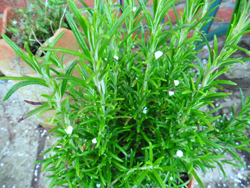
I did weaken and buy this packet of sprouting red cabbage seeds though: they sound such good value: apparently they ‘have a subtle flavour and crisp texture, are fantastic in salads and sandwiches, have a high vitamin content, are as easy to grow as cress and are ready to harvest 5-10 days after sowing.’ Who can resist?
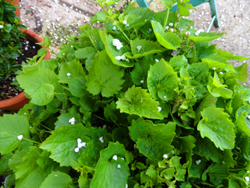 I’ve also bought new sage and rosemary plants to replace ones that have got too woody and depressing looking: they are such useful herbs. We had a beautiful big rosemary bush in our old garden but I can’t seem to establish one in the ground here, hardly surprisingly as rosemary thrives in free draining soil.
I’ve also bought new sage and rosemary plants to replace ones that have got too woody and depressing looking: they are such useful herbs. We had a beautiful big rosemary bush in our old garden but I can’t seem to establish one in the ground here, hardly surprisingly as rosemary thrives in free draining soil.
We only eat modest amounts of tomatoes at home so rarely grow them from seed these days. Gardener’s Delight is our favourite: Tumbling Tom and Sweet Million can be a bit too sweet and seem to go mushy quickly. We prefer our tomatoes tarter and firmer.  I bought a single lonely looking Gardener’s Delight plant - the last on the shelf at our local Waitrose and looking a bit miserable - but wouldn’t mind a couple more.
I bought a single lonely looking Gardener’s Delight plant - the last on the shelf at our local Waitrose and looking a bit miserable - but wouldn’t mind a couple more.
On the flower front, I’ve bought a few more violas: they are so cheering to look at and edible too: equally lovely scattered in salads or over iced cakes. When it comes to violas, I’m too impatient to grow them from seed.
I also fell for a gorgeous modern scented pink, called ‘Charmy’. You can see it standing up well to a recent hailstorm in the photo.
It may not be an old variety (bred around 2012, I think) but it smells beautifully of cloves in the old fashioned way. 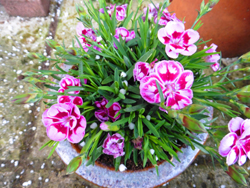 Instead of having several kinds of old-fashioned pinks: Doris, Gran’s Favourite, Mrs Sinkins (not Simkins, unfortunately!) and so on as I have in the past I’m going to put all my energy into this one strong, stocky specimen. I understand it can start flowering as early as March and continues through the summer.
Instead of having several kinds of old-fashioned pinks: Doris, Gran’s Favourite, Mrs Sinkins (not Simkins, unfortunately!) and so on as I have in the past I’m going to put all my energy into this one strong, stocky specimen. I understand it can start flowering as early as March and continues through the summer.
Pinks are edible too: one old variety, now classified as a rare plant, dating from Shakespeare’s time is called ‘Sops in Wine’. The flowers were floated in wine to give it a clove-like flavour. Worth a try! It must be a bit like a summer version of mulled wine.
 PS
PS
When the weather is miserable outside, a couple of jolly knitted cacti inside are just the thing to cheer you up.
Rare Mammatus Clouds Sighting
We saw the most amazing sight on Tuesday (April 26th). At around 6 o’clock the sky near us was quite blue over to the south but dark and dramatic with low black rain clouds to the north. There was a whole bank of strange drooping pouch type clouds – a bit like a bunch of grapes lying on its side. These turned out to be mammatus clouds which I don’t remember ever seeing before. They are quite rare in the UK.
Unfortunately, we were all in the car at the time with no camera so I couldn’t take any photos.
Here’s what Wikipedia has to say about them:
Mammatus are pouch-like cloud structures. They're also a rare example of clouds in sinking air-- most clouds form in rising air. 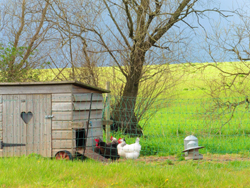 Although mammatus most frequently form on the underside of a cumulonimbus, they can develop underneath cirrocumulus, altostratus, altocumulus and stratocumulus.
Although mammatus most frequently form on the underside of a cumulonimbus, they can develop underneath cirrocumulus, altostratus, altocumulus and stratocumulus.
https://en.wikipedia.org/wiki/Mammatus_cloud
Here are our hens yesterday clustered round the coop door an hour before the mammatus clouds appeared: the northern sky behind them looks very ominous.
We’d had several hail and sleet showers during the day interspersed with sunshine. And then, this morning we woke up to a frost. On the way to the car at 7am a swallow flew past: probably on his way back to Africa!
A couple of hours later the sun was shining: by teatime we were having another hailstorm.
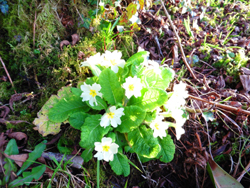 I have to admit, I’m far too ambitious every year and I’m pretty sure all but the very wisest gardeners are exactly the same. I try to grow far too many kinds of plants and have packets and packets of seeds in my seed box: lots were free gifts or presents admittedly, but quite a few bear witness to the relentless siren call of the seed catalogue.
I have to admit, I’m far too ambitious every year and I’m pretty sure all but the very wisest gardeners are exactly the same. I try to grow far too many kinds of plants and have packets and packets of seeds in my seed box: lots were free gifts or presents admittedly, but quite a few bear witness to the relentless siren call of the seed catalogue.
Talk about: ‘the triumph of hope over experience’. The reality is, unless you devote virtually every waking hour to the garden from early spring to late autumn, there is  only so much you can look after successfully in any one year.
only so much you can look after successfully in any one year.
Gardeners’ Reality Check
So this is it: this is the year I take a reality check. Perennial plants and self-seeders are establishing nicely in the garden now so I’m going to spend my time more profitably on fewer new plants and varieties.
 So, far, I have bought only 3 packets of seeds: ‘Halloween’ pumpkin, ‘Gro-Sure Easy Grow American Giant’ sunflowers with extra sturdy stems that don’t need staking (Fall for hype? Me? Never!) and a packet of really interesting seeds from Lidl I just couldn’t resist called ‘Anti-Slug & Snail Plants’ and I intend to buy hardly any more. (I’ll keep you posted!)
So, far, I have bought only 3 packets of seeds: ‘Halloween’ pumpkin, ‘Gro-Sure Easy Grow American Giant’ sunflowers with extra sturdy stems that don’t need staking (Fall for hype? Me? Never!) and a packet of really interesting seeds from Lidl I just couldn’t resist called ‘Anti-Slug & Snail Plants’ and I intend to buy hardly any more. (I’ll keep you posted!)  I’ve had a ruthless pot and trough cull on the patio as apart from anything else; I want to really cut down on the amount of container watering over the summer.
I’ve had a ruthless pot and trough cull on the patio as apart from anything else; I want to really cut down on the amount of container watering over the summer.
I’m only going to grow a few manageable vegetables this year, the ones we love, are worth growing economically and that we’d miss having: courgettes, pumpkins for Halloween, sweet corn, salad leaves and herbs and a few other bits and pieces.
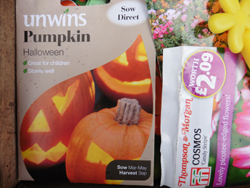 Wet Garlic Hopes
Wet Garlic Hopes
I’d hoped to grow some garlic to harvest as wet garlic this year but think I may have missed the boat. I’m also going to try sowing some carlin peas to see what happens.
Chamomile, Bistort, Zinnia’s and Slug Slayers
On the flower side, I’d like to establish some chamomile and bistort (for Easter Ledge pudding). I’ll grow sunflowers and the usual hardy annuals for the vegetable plot, keep titivating my ‘mini-meadow’ and make a big effort with zinnia this year.  I’m really intrigued by (see above) anti-slug and snail seeds; the plants probably just secrete certain ‘exudates’ that make the plants unappealing to the munching molluscs and keep them away from the area generally.
I’m really intrigued by (see above) anti-slug and snail seeds; the plants probably just secrete certain ‘exudates’ that make the plants unappealing to the munching molluscs and keep them away from the area generally.
And of course, I shall net the raspberries and strawberries this year before the deer get them. Rhubarb is doing well and the blackcurrants are looking hopeful.
‘April is the cruellest month . . . .’
Taking TS Eliot’s famous line from The Wasteland totally out of context, and purely from a gardener’s point of view, you could say it describes the English April in a nutshell.

This year’s April seems even more cruel than usual: one day the sun’s out, everything wakes up and starts unfolding and you start making plans; the next day dawns with frost followed by biting winds, hail and icy rain. Suddenly it’s winter again. The cruelty lies in the bitter dashing of hope and blighted buds and blossoms.
April in the garden can be a real roller coaster of hope and disappointment. Oh, hang on, that’s gardening in general, isn’t it? Oh, dear, clearly the weather is affecting my mood more than I thought!
 Over by the brook opposite our house I noticed the first celandine flowering here on February 23rd. They’re lovely in the wild and a real harbinger of early spring (they were the first flowers to appear in Narnia after the White Witch was defeated, in case you’re interested) but can be a bit of pain if they decide to run riot over your garden which they can so easily do. I saw some garden variety ‘Brazen Hussey’ for sale at a marked down price this mornin
Over by the brook opposite our house I noticed the first celandine flowering here on February 23rd. They’re lovely in the wild and a real harbinger of early spring (they were the first flowers to appear in Narnia after the White Witch was defeated, in case you’re interested) but can be a bit of pain if they decide to run riot over your garden which they can so easily do. I saw some garden variety ‘Brazen Hussey’ for sale at a marked down price this mornin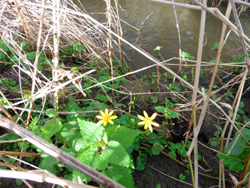 g. I thought ‘brazen’ is right! Apparently they don’t spread nearly as much as the wild ones but I decided against them and left them on the shelf.
g. I thought ‘brazen’ is right! Apparently they don’t spread nearly as much as the wild ones but I decided against them and left them on the shelf.
Garden Mainly Sulking but Signs of Hope
I had a quick inspection of the garden yesterday and quite depressing it was too. More or less everything was struggling in a sea of mud, cold and miserable and wind-blown. Things will be better in a month or two after some warmer weather and a good clear up. At least the beech hedge 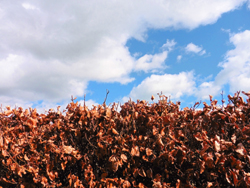 is looking cheerful: you can always rely on beech, it’s such a fantastic hedging plant and looks good all year round.
is looking cheerful: you can always rely on beech, it’s such a fantastic hedging plant and looks good all year round.
Another heartening sight was this clump of our native hellebore, known as stinking hellebore or hellebore foetidus: it gets bigger every year. It’s a woodland plant and seems happy here under the beech, preferring deep, fertile, moist, humus rich yet well-drained soil, and dappled shade. They came with us from our old garden several years ago and are establishing well now.
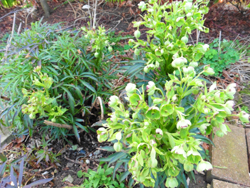 I adore all kinds of hellebore but have always had a soft spot for these. Tall and elegant, the green bells are so beautiful with deep crimson borders to the petals if you get up close. Try not to crush the leaves though, as then you will understand completely why they are called ‘stinking’!
I adore all kinds of hellebore but have always had a soft spot for these. Tall and elegant, the green bells are so beautiful with deep crimson borders to the petals if you get up close. Try not to crush the leaves though, as then you will understand completely why they are called ‘stinking’!
Ironically, the garden’s nemesis of last summer, the deer, were browsing over in the field whilst I was in the garden, looking over occasionally to see what was going on.
There are 4 altogether who come regularly but one of them kept wandering off.


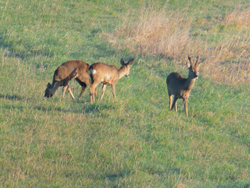
Hope the lupins return to their summer glory.


Hope the sadly defeated looking candelabra primroses do too: you might be able to just see how wonderful they looked in June. They’re in the background behind the plate of strawberry tarts.
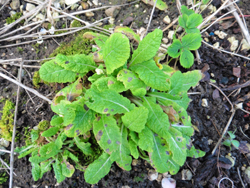

The borde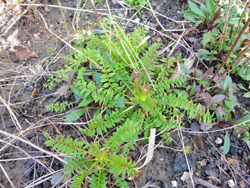 r is full of blue Jacob’s ladder; there are white ones as well.I’m really looking forward to seeing both again.
r is full of blue Jacob’s ladder; there are white ones as well.I’m really looking forward to seeing both again.
Here are some strawberry plants which I hope we can protect from the deer and actually eat the fruit this summer. 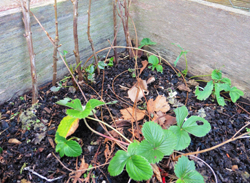 Can you see last year’s blackcurrant cuttings also in the ‘fruit nursery box’? I have high hopes of those cuttings.
Can you see last year’s blackcurrant cuttings also in the ‘fruit nursery box’? I have high hopes of those cuttings.
Kamikaze Aphids
It’s a sad fact that if you bring plants from outside over the winter you are bound to get a few flurries of aphids in the house at some point, or even worse, whitefly.
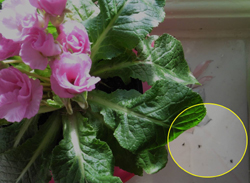 This lovely pink ‘Primlet’ primrose sat on our bathroom window sill for a couple of weeks and was host to some amazingly obliging kamikaze aphids. Every morning, they seemed to dive off the plant and onto the window sill which was wet with condensation. The poor mites died instantly. Others stuck themselves to the wet window and suffered the same fate.
This lovely pink ‘Primlet’ primrose sat on our bathroom window sill for a couple of weeks and was host to some amazingly obliging kamikaze aphids. Every morning, they seemed to dive off the plant and onto the window sill which was wet with condensation. The poor mites died instantly. Others stuck themselves to the wet window and suffered the same fate.
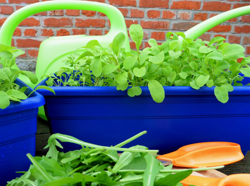 Hooray for Rocket
Hooray for Rocket
Thank goodness for rocket: it’s absolutely delicious, full of nutrients, endlessly versatile and you can grow it under cover over the winter – in fact you can grow it in all but the very hottest months of the year - when it runs up to seed. Even then, the flowers and seed pods look and taste good in salads and you can save the seed for sowing.
Re saving seed, here’s a wise word of warning from horticulturist and much-missed former presenter of Gardener’s World, Alys Fowler:
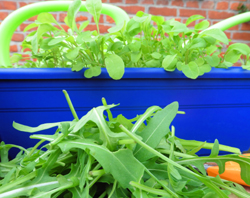 It's never advisable to save seed of the first plant that bolted as this will perpetuate early flowering and thus fewer leaves to eat.
It's never advisable to save seed of the first plant that bolted as this will perpetuate early flowering and thus fewer leaves to eat.
I think I’m going to start a campaign: Bring Back Alys Fowler! And bring back Toby Buckland whilst you’re at it!
I love both cultivated and wild rocket and apart from during the height of summer, usually have some on the go: I’ve got a couple of mini-troughs of cultivated rocket on the landing window sill at the moment (happily free from aphids, see above). Salad leaves are best grown under cover in winter: they can turn very tough and leathery out on the plot.
Cultivated, salad or garden rocket is mainly oval in shape with a milder, creamier taste when young. 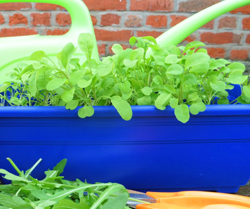 It turns bitter as it ages, a bit like dandelion leaves do – they’re nice when very small but far too bitter once they start growing away. (Incidentally, have you ever eaten borage leaves? Nicely cucumber-y in flavour when tiny but they soon become bristly monstrosities!)
It turns bitter as it ages, a bit like dandelion leaves do – they’re nice when very small but far too bitter once they start growing away. (Incidentally, have you ever eaten borage leaves? Nicely cucumber-y in flavour when tiny but they soon become bristly monstrosities!)
Wild rocket has much more deeply serrated edges and a stronger taste. It doesn’t turn bitter quite so soon and is the better choice for wilting and cooking.
Cooking with Rocket
Rocket is obviously fabulous as a salad leaf picked as both micro and baby leaves, but it’s also terrific wilted over pizza, pasta or roasted vegetables just before serving, stirred into soups, curries and risottos at the last minute, or cooked briefly like spinach. You can even make pesto with it.

More robust wild rocket is better for wilting and cooking: I’ll post some recipes soon; but until then just a quick tip: chop rocket before wilting or cooking, paying particular attention to the stalks, which can be slightly stringy otherwise.
Cut and Come Again Yourself
If you’ve got a trough or pot on the go which has been grown inside, it’s quite fun to put it on the meal table with a pair of scissors and let everyone harvest their own. 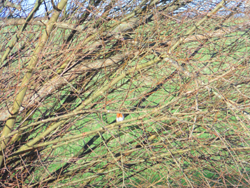 And you can’t get fresher than that!
And you can’t get fresher than that!
Where’s
Robin?
Taking pictures of a moving subject is usually fraught with aggravation: look at this photo of a robin in a willow tree.
I came home one morning recently and there was a robin, perched among the bare wintry branches just across the brook from where we park out cars.
My camera was unfortunately inside the house 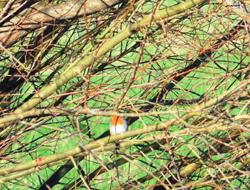 so I just stood watching for a while. It showed no sign of moving so I thought I’d risk nipping inside quickly and fetching the camera.
so I just stood watching for a while. It showed no sign of moving so I thought I’d risk nipping inside quickly and fetching the camera.
I got the camera, focussed and it was still there! Hooray! I managed one shot before it flew off.
Later, I realised that right at the crucial moment it had ducked its head behind a branch. Typical!!* Now the photo looks like one of those 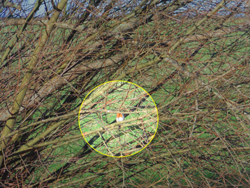 ‘Where’s Wally?” puzzles.
‘Where’s Wally?” puzzles.
*Incidentally, has it ever struck you that only English people say ‘typical’ in such a loaded and significant way? English character specialist Kate Fox, author of that fantastic book: ‘Watching the English’ put her finger on it at the Cheltenham Literary Festival a couple of years ago:
. . . you have to be able to say it in a way that sounds 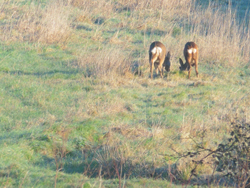 simultaneously peeved, but also kind of stoically resigned, and at the same time smugly omniscient — almost pleased that your predictions have been fulfilled . . . everything may have gone completely pear-shaped, but you weren’t taken unawares.
simultaneously peeved, but also kind of stoically resigned, and at the same time smugly omniscient — almost pleased that your predictions have been fulfilled . . . everything may have gone completely pear-shaped, but you weren’t taken unawares.
And here's what the deer think of our attempts to deer-proof the garden!
Very, Very Early Blackthorn Blossom
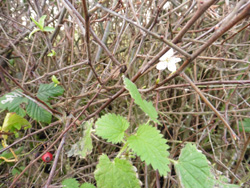 So we had a mild Christmas after all. I got my hopes up on Christmas Eve: we went to Midnight Mass and it was beautifully clear and frosty. Not so Christmas morning: the day dawned mild and murky. If there’s no change in the weather soon gardening this year could be a full-on battle against pests and diseases!
So we had a mild Christmas after all. I got my hopes up on Christmas Eve: we went to Midnight Mass and it was beautifully clear and frosty. Not so Christmas morning: the day dawned mild and murky. If there’s no change in the weather soon gardening this year could be a full-on battle against pests and diseases!
We went for a long walk on December 29th and the weather was still unseasonably mild. 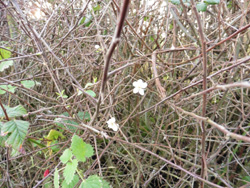 The hedgerow seemed full of contrasts: rosehips and the odd hawthorn berry from last autumn side by side with a couple of unusually early blackthorn blossoms. Blackthorn doesn’t normally flower until early March so December 29th must be slightly exceptional!
The hedgerow seemed full of contrasts: rosehips and the odd hawthorn berry from last autumn side by side with a couple of unusually early blackthorn blossoms. Blackthorn doesn’t normally flower until early March so December 29th must be slightly exceptional!
Oak Apples and Fairy Lights
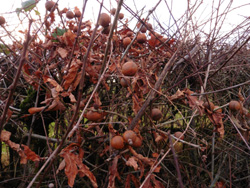 I also noticed this crop of oak apples in the hedge. Oak apples look like some kind of alternative fruit to acorns or something but are actually galls caused by a tiny wasp.
I also noticed this crop of oak apples in the hedge. Oak apples look like some kind of alternative fruit to acorns or something but are actually galls caused by a tiny wasp.
A gall is an abnormal growth of plant tissues, similar to a benign tumours or a wart in mammals.
The female gall wasp lays her eggs into parts of the oak tree - usually emerging leaf buds.
 Once hatched each little larva secretes chemicals that reorganises the oak's normal growth pattern. Instead of producing normal oak tree tissue, a gall is created around the developing larvae. Inside each gall there are several compartments, each holding a larva which eventually eats its way out. Adults emerge in June and July.
Once hatched each little larva secretes chemicals that reorganises the oak's normal growth pattern. Instead of producing normal oak tree tissue, a gall is created around the developing larvae. Inside each gall there are several compartments, each holding a larva which eventually eats its way out. Adults emerge in June and July.
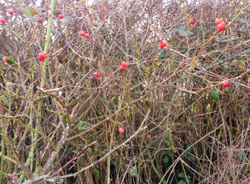 Iron Gall Ink
Iron Gall Ink
Oak galls, mixed with iron salts, have been used to make ink - known as iron gall ink - probably since Roman times. The standard ink for centuries, you can still buy it from specialist suppliers today.
Oak Apple Folklore: Foretelling the Farming Year
 According to folklore, if a grub is found inside a gall on Michaelmas Day (September 29th) the year will be pleasant and unexceptional, there’s a spider inside, it will be a bad year with shortages and ruined crops. If it’s a fly, it will be a moderate season, if nothing at all is inside, serious diseases will occur all that year
According to folklore, if a grub is found inside a gall on Michaelmas Day (September 29th) the year will be pleasant and unexceptional, there’s a spider inside, it will be a bad year with shortages and ruined crops. If it’s a fly, it will be a moderate season, if nothing at all is inside, serious diseases will occur all that year
Rosehip Fairylights
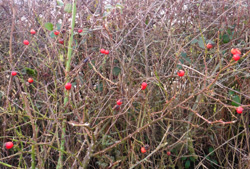 I love having all the Christmas decorations up in the house so much and always wait until the last possible moment on Twelfth Night to take them down. These rosehips made me smile as they made the hedge look as though it was decked out with its own outdoor illuminations!
I love having all the Christmas decorations up in the house so much and always wait until the last possible moment on Twelfth Night to take them down. These rosehips made me smile as they made the hedge look as though it was decked out with its own outdoor illuminations!
Lovely Sprouts: Red, Green and Flower Varieties
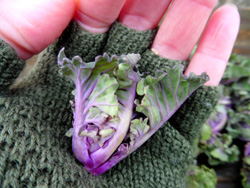 Much like Marmite, you either love Brussels sprouts or hate them. We all love them in our family but others can find them bitter and nasty.
Much like Marmite, you either love Brussels sprouts or hate them. We all love them in our family but others can find them bitter and nasty.
Generally, for those of us who enjoy them; sprouts have a milder, nuttier flavour than other brassicas but in recent years breeders have tried to breed even milder, sweeter varieties to appeal to children and confirmed sprout-avoiders.
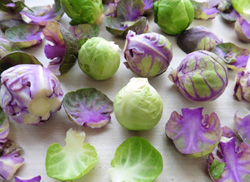 These include red or ruby sprouts such as ‘Redarling’ and flower sprouts such as ‘Petit Posy’. Personally, I don’t know why they are called red as they look purple to me!
These include red or ruby sprouts such as ‘Redarling’ and flower sprouts such as ‘Petit Posy’. Personally, I don’t know why they are called red as they look purple to me!
Red sprouts are a milder flavoured Brussels sprout and flower sprouts a mild and nutty sprouts/kale cross.
Both are pretty to look at, the flower sprouts in particular look like dainty little miniature ornamental cabbages. 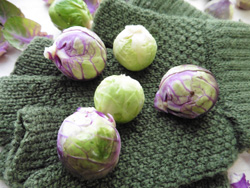 Cook and serve both as you would Brussels sprouts. I’m not convinced they actually taste that much milder and sweeter than a lovely fresh button sprout but I like them anyway!
Cook and serve both as you would Brussels sprouts. I’m not convinced they actually taste that much milder and sweeter than a lovely fresh button sprout but I like them anyway!
Extremely nutritious, sprouts are a brilliant source of vitamin C, vitamin D, folic acid and fibre: plus, they have higher levels of glucosinolates than other brassicas. These are health giving compounds that may help to prevent cancer.
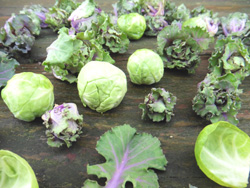 I haven’t attempted to grow sprouts for years: I wasn’t entirely unsuccessful on my last try: but the few sprouts I harvested were absolutely delicious. I was gardening on a very windy open site though, it wasn’t entirely to their liking and many of the plants fell over.
I haven’t attempted to grow sprouts for years: I wasn’t entirely unsuccessful on my last try: but the few sprouts I harvested were absolutely delicious. I was gardening on a very windy open site though, it wasn’t entirely to their liking and many of the plants fell over.
I’m wondering about having another go this year: my neighbour is always very successful but my patch is especially water-logged in winter and fairly windy. I wouldn’t mind trying flower sprouts: pretty to look at and delicious!
I wouldn’t mind trying flower sprouts: pretty to look at and delicious!
Sprouts Cultivation Notes
Sprouts are tolerant of almost all soil conditions (hooray!) although they dislike acidic soils which can make them susceptible to clubroot. (That’s fine as we aren’t especially acid.)
Because Brussels sprouts are a ‘top heavy’ crop, they are need a rich, firm, heavy soil so the roots can 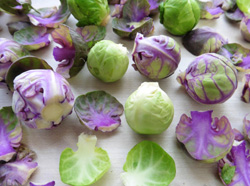 get a good grip and support the heavy tops, anchoring them safely in poor weather. (We have the rich and heavy part.)
get a good grip and support the heavy tops, anchoring them safely in poor weather. (We have the rich and heavy part.)
Their bed should be nicely dug over with plenty of well-rotted farmyard manure (FYM) added to it well in advance of planting – preferably completed a few months earlier. (Now you see, that’s where I fall down: I have access to excellent FYM but can never quite find the time, well in advance or otherwise, to get the digging done.)
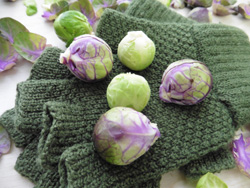 Both kinds of sprouts grow well in sun or partial shade, although partial shade is slightly preferable. Avoid growing them directly in front of plants that enjoy full sun, they are large and sturdy plants, in the ground for a long season and will literally leave others in the shade.
Both kinds of sprouts grow well in sun or partial shade, although partial shade is slightly preferable. Avoid growing them directly in front of plants that enjoy full sun, they are large and sturdy plants, in the ground for a long season and will literally leave others in the shade.
Good Companions
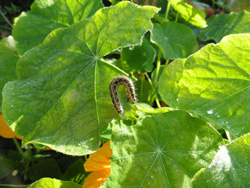 Nasturtiums work well as companion plants with brassicas: they look lovely and cabbage white butterflies tend to be drawn to them rather than the crop. Mint can help deter flea beetle (they are the ones that leave all those pin-prick holes in the foliage) but mind it doesn’t get too invasive.
Nasturtiums work well as companion plants with brassicas: they look lovely and cabbage white butterflies tend to be drawn to them rather than the crop. Mint can help deter flea beetle (they are the ones that leave all those pin-prick holes in the foliage) but mind it doesn’t get too invasive.
Both sprouts seeds can be sown April – June: either direct in the ground or in pots to plant out later.
Why are they called Brussels sprouts?
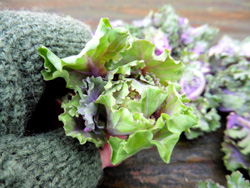 Incidentally, if you have ever wondered why they are called ‘Brussels’ sprouts it’s because they may have been grown in Belgium since the thirteenth century and so were named after the capital. It’s possible they originally came from in Ancient Rome and seem to have appeared in Britain in the 1500s. I wonder why they aren’t called Roman or Belgian Sprouts?
Incidentally, if you have ever wondered why they are called ‘Brussels’ sprouts it’s because they may have been grown in Belgium since the thirteenth century and so were named after the capital. It’s possible they originally came from in Ancient Rome and seem to have appeared in Britain in the 1500s. I wonder why they aren’t called Roman or Belgian Sprouts?
Cooking Sprouts
Obviously, the worst thing you can do to any kind of sprout is overcook it. 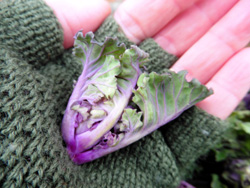 Overcooking releases the sulphurous compounds that turn them evil smelling and bitter.
Overcooking releases the sulphurous compounds that turn them evil smelling and bitter.
You can’t go wrong with steaming: for 3-5 minutes depending on size or cut into halves and stir-fry for the same amount of time.
Meandering Brook
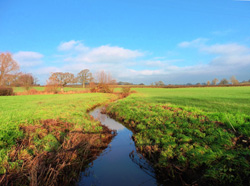 There was more welcome but unseasonable sun on Twelfth Night. You can see the way this little brook or stream meanders through the (heavy clay) meadow near us. The curving is caused over time by erosion and something complicated to do with sediment but to understand exactly how and why this happens you would need a degree in fluid mechanics!
There was more welcome but unseasonable sun on Twelfth Night. You can see the way this little brook or stream meanders through the (heavy clay) meadow near us. The curving is caused over time by erosion and something complicated to do with sediment but to understand exactly how and why this happens you would need a degree in fluid mechanics!
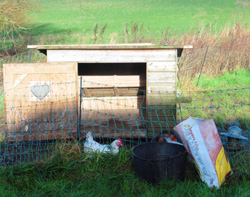 I have nothing of the sort but remember hearing once that a river or stream doesn’t necessarily follow the most efficient course but the most stable. However it happens, a stream gently meandering through a meadow is always the most soothing and relaxing sight particularly on a sunny day.
I have nothing of the sort but remember hearing once that a river or stream doesn’t necessarily follow the most efficient course but the most stable. However it happens, a stream gently meandering through a meadow is always the most soothing and relaxing sight particularly on a sunny day.
You can say that again! Autumn has certainly flown this year. In fact more or less the whole of 2015 seems to have taken place in a high-speed time warp!
Apologies for lack of garden blogs recently – there seems to have been so much to do and as I say, time has passed super-fast.
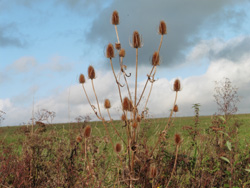 A combination of our customary winter-waterlogging and some quite extreme bad-weather: since September storms Abigail, Barney, Clodagh and Desmond* have put paid to any ground work in the garden but there is still plenty of tidying up to be done as long as you stay off the actual soil. And of course, it’s as good a time as any to reflect on what has been good and bad this last season and plans for next year. It is Advent, after all.
A combination of our customary winter-waterlogging and some quite extreme bad-weather: since September storms Abigail, Barney, Clodagh and Desmond* have put paid to any ground work in the garden but there is still plenty of tidying up to be done as long as you stay off the actual soil. And of course, it’s as good a time as any to reflect on what has been good and bad this last season and plans for next year. It is Advent, after all.
As you probably know by now, the Met office recently ran a public competition via social media to choose names for UK storms throughout the winter of 2015-16. This is to raise awareness of severe weather conditions and impending storms.
Here’s the full list of 21 names: Abigail, Barney, Clodagh, Desmond, Eva, Frank, Gertrude, Henry, Imogen, Jake, Katie, Lawrence, Mary, Nigel, Orla, Phil, Rhonda, Steve, Tegan, Vernon and Wendy. They are used in alphabetical order with alternate male/female names. So Storm Eva next then.
Here are some of the seeds and plants I grew this summer: I’ve highlighted ones I’ve either not grown before or ones I was particularly keen to grow again.
 Electric Daisies
Acmella olereacea
Electric Daisies
Acmella olereacea
Back in March I was keen as mustard to grow these strange little curiosities. They are meant to be edible with a kind of fun electric shock effect. I was thinking fizzy sherbet? Popping candy? Hot chilli? And I thought they would be great fun for friends and family to try.
The seeds germinated well and produced plants with loads of button-like little flowers: not the most attractive flower in the whole wide world it has to be said but they were a bright dandelion-yellow.
One warm summer evening I popped a flower in my mouth – on reflection, possibly a whole one may have been a bit rash – I think you are meant to chop them up into tiny pieces!
Anyway, very quickly, after the initial woolly, waddy-type of sensation, I experienced a really unpleasant metallic taste and one side of my face seemed to go completely numb: 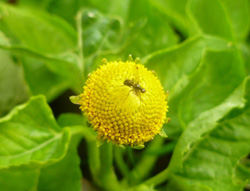 I think I may actually have started drooling from the side of my mouth!
I think I may actually have started drooling from the side of my mouth!
It lasted for quite a few minutes -10 or15 maybe before calming down. It was horrible!
I found out afterwards the active chemical they contain is spilanthol, a muscle relaxant which has apparently been used to treat toothache for centuries. More recently, it has been under investigation as a kind of alternative botox facial treatment.
Well, I don’t think I shall be growing those again unless a few hardy self-sown volunteers pop up next year. And no, I wouldn’t recommend them. I’m only thankful I didn’t offer them to friends and family!
Perpetual Strawberries 'Ostara' and Raspberries ‘Schonemann’
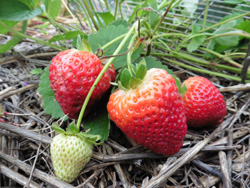 This has not been my year! Here’s another tale of woe. The eagerly anticipated raspberries and strawberries got off to a promising and well-nurtured start.
This has not been my year! Here’s another tale of woe. The eagerly anticipated raspberries and strawberries got off to a promising and well-nurtured start.
Then, overnight, as I mentioned, back in July, just as they were almost ready to pick, all the strawberry plants were eaten to the ground and the tops of the raspberries browsed by visiting deer! It was heart breaking. I’ve seen deer around in the fields of course, but it just didn’t occur to me, stupidly, it turns out, they would actually come in the garden.
Fast forward to the end of summer. I had netted the fruit and hoped for another crop. Again all went well until I unfortunately relaxed my guard one night and left the netting off. They were in there like a shot and everything was eaten.
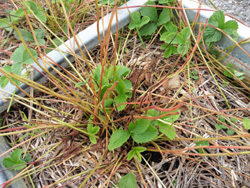 They even ate the strawberries I’d planted in a cattle trough. I say even, they probably thought they were planted there especially for them!
They even ate the strawberries I’d planted in a cattle trough. I say even, they probably thought they were planted there especially for them!
And . . . they even ate the top of our lovely new ‘Generous Gardener’ David Austin rose! Aaaargh!!
Still, at least they left the blackcurrants alone (I notice the RHS site lists Ribes as potentially worth trying where deer are a problem https://www.rhs.org.uk/advice/profile?pid=185) and we had quite a respectable crop, considering the bush had been moved at the start of the year. And of course, back in the spring, the rhubarb was brilliant.

Anyway, on to more promising things in the flower department. The honesty and everlasting pea seeds germinated nicely and I’m looking forward to more growth and flowers next year.
Mini Wildflower Meadow
The Mini Wildflower Meadow, whilst not exactly spectacular as a whole, had some beautiful individual stars. I think next year could be really good if self-sown seeds come up. Meadow flowers always seem better if they can choose their positions themselves. Special stars were:
phacelia, oxe-eye daisy, Shirley poppy, cornflower , and cosmos ‘Candy Stripe’.
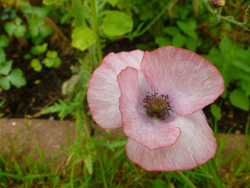
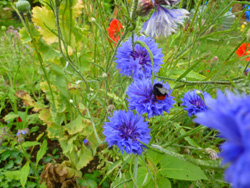
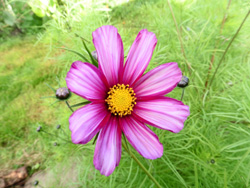
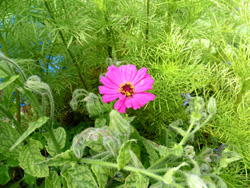
Zinnia ‘Purple Prince’ didn’t do too well overall: my fault entirely as the seedlings caught cold when I left them outside the kitchen door in early June.

We had some unexpected and unseasonable late chilly winds and we do get a kind of wind tunnel effect whipping through that spot. I was left with a lone survivor that was so lovely it made me all the more determined to grow them (and look after them properly) next year.
Other stars this year were the cardoons and Johnson’s Blue hardy geraniums from a friend’s garden, my established double feverfew that self-seeds in a restrained way (this is such a plant worth having) also originally from a friend’s garden, which all put on a great show.
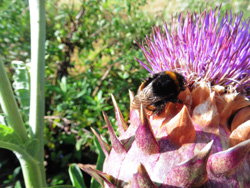

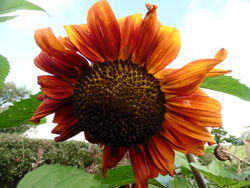 The Sunflower ‘Mongolian Giant’ was a bit disappointing in that some were eaten by slugs and the ones that did survive were a bit depressed and lack-lustre but ‘Velvet Queen’ grew really well. It’s a modest 5 feet tall with deep red petals and put on fantastic show of multiple flowers. I marvelled at it every time I hung out my washing!
The Sunflower ‘Mongolian Giant’ was a bit disappointing in that some were eaten by slugs and the ones that did survive were a bit depressed and lack-lustre but ‘Velvet Queen’ grew really well. It’s a modest 5 feet tall with deep red petals and put on fantastic show of multiple flowers. I marvelled at it every time I hung out my washing!
Vegetables
It’s not been the best year for vegetables either: courgettes weren’t as good as usual and although we had enough we didn’t get the usual bounty. Pumpkins and butternut squash were actually pretty disastrous. I had to buy a couple of pumpkins for Halloween.



I’ll definitely grow Arran Pilot again!
Potatoes were good, especially the early Arran pilot, the runner beans were a little tough, my fault as I didn’t water them often enough. The late peas were unfortunately eaten by slugs.
And I’ll definitely have another go at Echallions
The echallions (banana shallots) I grew from seed were fine but could have been so much bigger and better if I had given them more space and care. Next year definitely: they’re going to be fantastic!
Tomatoes and Chillies
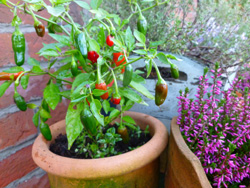 Tomatoes were a bit rubbish this year as blight struck again but Prairie Fire chillies from seed and Apache from a reduced plant for sale I felt sorry for were great. Loads of fiery little mini-chillies to use fresh from the plants for the freezer, plus I’ve managed so far to bring in and save 3 Prairie Fire plants and the Apache.
Tomatoes were a bit rubbish this year as blight struck again but Prairie Fire chillies from seed and Apache from a reduced plant for sale I felt sorry for were great. Loads of fiery little mini-chillies to use fresh from the plants for the freezer, plus I’ve managed so far to bring in and save 3 Prairie Fire plants and the Apache.
I even had enough to make some decorative chilli loops – great as edible Christmas decorations: just thread a dozen together using a needle and thread and tie the ends together.
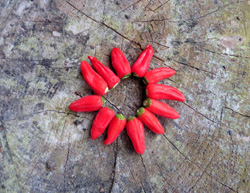 Anyway, not to worry it’s still a fairly new garden and I did manage to get lots of groundwork done, all the beds are established now, the shed is sorted and more hardy plants have been established so I can start immediately on the growing next year without getting side-tracked.
Anyway, not to worry it’s still a fairly new garden and I did manage to get lots of groundwork done, all the beds are established now, the shed is sorted and more hardy plants have been established so I can start immediately on the growing next year without getting side-tracked.
Moth in a Fur Coat (Insect Guest: not a real pest this time)
This glamorous insect is a female Oak Eggar moth Lasiocampa quercus we spotted on our window in early August 2012. I came across the old photo in my folder the other day and thought it would be interesting to look it up. The name oak eggar has nothing to do with oak trees but describes the papery cocoons of the pupae which apparently (although I’ve never seen one myself, I only wish I had) look just like little acorns.
You can tell this moth is a female as her fur coat, with the distinctive pale band across the wings, is golden brown: the male’s is much darker. The female is larger overall than the male but has smaller antennae whereas he is smaller but has larger feathery antennae.
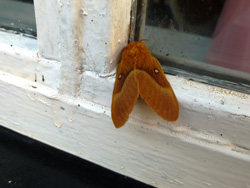 The female flies at night but the male flies during the day. He uses his large feathery antennae to pick up the scent of the female as she slumbers. An unmated female gives off such strong pheromones that, according to my old biology teacher, the male can smell her from 3 miles away. (I looked this up to check and she was right, it can be a distance of 1-3 miles).
The female flies at night but the male flies during the day. He uses his large feathery antennae to pick up the scent of the female as she slumbers. An unmated female gives off such strong pheromones that, according to my old biology teacher, the male can smell her from 3 miles away. (I looked this up to check and she was right, it can be a distance of 1-3 miles).
Once he has mated, the male completely loses interest in her and goes off in search of other females.
She is left to fly alone at night and lay her eggs: she makes no special arrangements for this: she just lays them as she flies over suitable egg-rearing habitat - heaths and moors or sometimes light woodland.
The eggs, hatch at the end of the summer: the larvae, left to do the best they can without parental guidance, will eat heather, bilberry, bramble, blackthorn or hawthorn.
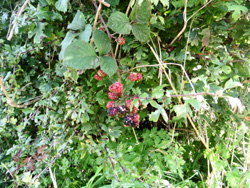 Whilst still quite small they go into hibernation but start to grow again the following spring.
Whilst still quite small they go into hibernation but start to grow again the following spring.
The larvae (generally, butterflies have caterpillars, moths have larvae, incidentally) are dark brown with a line of white spots and tufts of hair. The hairs can cause skin irritation and defend against predators.
Strangely, the cuckoo is especially fond of hairy caterpillars such as these and is immune to the irritating hairs.
So basically, at all stages of life, the oak eggar moth is a completely independent and usually solitary, creature. Not unlike its nemesis the cuckoo then!
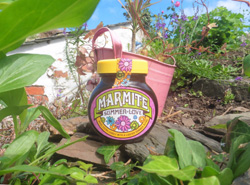 Apologies for the distinct lack of blogs over the summer: original intentions were good but summery stuff just kept on happening and inevitably time ran out! Honestly, you go on holiday for 2 weeks, you spend the previous 2 or 3 at least, preparing and clearing your desk, you go on holiday, come back and spend the next 2 or 3 weeks unpacking and getting to grips with the all work that’s piled up whilst you were away. Meanwhile, the garden is becoming increasingly desperate for attention . . . .
Apologies for the distinct lack of blogs over the summer: original intentions were good but summery stuff just kept on happening and inevitably time ran out! Honestly, you go on holiday for 2 weeks, you spend the previous 2 or 3 at least, preparing and clearing your desk, you go on holiday, come back and spend the next 2 or 3 weeks unpacking and getting to grips with the all work that’s piled up whilst you were away. Meanwhile, the garden is becoming increasingly desperate for attention . . . .
 We are all dedicated Marmite fans at home and fell in love with this summer limited edition jar. The label design is so pretty and summery; apparently, according to the official Marmite website, it takes its inspiration from ‘Woodstock and the ‘Summer of Love’ in 1967’ and the jars are intended to ‘spread peace, love and hippy vibes throughout the summer.’ And why not!
It’s meant to be ‘a delicately flavoured adaptation of the much-loved recipe, made with 100% lager yeast for a slightly lighter taste’. We couldn’t detect a massive difference but, whatever; we loved it anyway and took a jar with us on holiday to Cornwall. It blends right in with the plants on this roof!
We are all dedicated Marmite fans at home and fell in love with this summer limited edition jar. The label design is so pretty and summery; apparently, according to the official Marmite website, it takes its inspiration from ‘Woodstock and the ‘Summer of Love’ in 1967’ and the jars are intended to ‘spread peace, love and hippy vibes throughout the summer.’ And why not!
It’s meant to be ‘a delicately flavoured adaptation of the much-loved recipe, made with 100% lager yeast for a slightly lighter taste’. We couldn’t detect a massive difference but, whatever; we loved it anyway and took a jar with us on holiday to Cornwall. It blends right in with the plants on this roof!
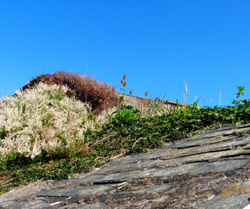 Cornish Roof Tops
Cornish Roof Tops
Traditional Cornish roofs are tiled with slate and often festooned with a brilliant mix of plant life. Here’s a typical cottage shed roof coved in mile-a-minute (Fallopia baldschuanicum or Russian Vine), ivy, ferns, a few other bits and pieces and an opportunist teasel.
Cat on a Warm Slate Roof
Here’s the next roof along with a lovely friendly cat. You can see this one’s growing plenty of red valerian (known as ‘Padstow Pride’ in parts of North Cornwall) 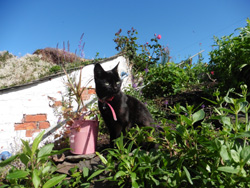 lavender and there’s even a pink rose to gladden the heart even more. It’s lovely to see cats again in Cornwall. Twenty years ago they were all over the place but now you’re lucky to see any at all in the older coastal villages. This is because all the old cottages have been converted to holiday homes and few people actual live in them anymore.
lavender and there’s even a pink rose to gladden the heart even more. It’s lovely to see cats again in Cornwall. Twenty years ago they were all over the place but now you’re lucky to see any at all in the older coastal villages. This is because all the old cottages have been converted to holiday homes and few people actual live in them anymore.
Red Valerian
Centranthus ruber
Red valerian or centranthus ruber – not to be confused with true valerian or Valeriana officinalis.
 I always thought red valerian came over to Britain with the Romans but it didn’t actually arrive from mainland Europe until the 16th century. First grown in gardens, it didn’t take long to escape into the wild and rampage its way around the country.
I always thought red valerian came over to Britain with the Romans but it didn’t actually arrive from mainland Europe until the 16th century. First grown in gardens, it didn’t take long to escape into the wild and rampage its way around the country.
I love it and it always makes me think of country cottage and coastal gardens in the West Country. A lovely splash of colour, tough and hardy, a perennial, yet self-seeding freely, loved by butterflies, what’s not to like? There are white and paler pink varieties too.
 Apart from ‘Padstow Pride’ (above) some of its other names are: kiss-me-quick, fox's brush, and Jupiter's beard.
Apart from ‘Padstow Pride’ (above) some of its other names are: kiss-me-quick, fox's brush, and Jupiter's beard.
It’s hard to believe it’s classified as an environmental weed in Tasmania and parts of Australia.
Red Hot Pokers at Sea
These red hot pokers or Kniphofia tritoma look fantastic growing along the cliff top. 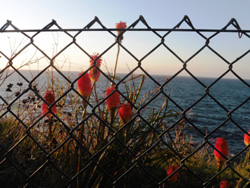 Also known as torch lily, they were first collected in the 1700s in South Africa by German physician and botanist Johann Hieronymus Kniphof and named in his honour.
Also known as torch lily, they were first collected in the 1700s in South Africa by German physician and botanist Johann Hieronymus Kniphof and named in his honour.
These even look good behind a chain link fence, something you usually associate with urban and suburban areas.
Red hot pokers are one of the 3 clump forming plants I always associate with late summer in Cornwall: the others are red valerian (see above) and monbretia, now known as crocosmia.

Wasp: Netelia testacea
We weren’t exactly sure what this thin reddish insect with the curly feelers was when we found it on the kitchen window sill. We thought it might be a kind of mosquito and Googled it immediately in case we were in danger of some nasty bites. Turns out it’s a species of parasitic wasp, very likely something called: Netelia testacea from the Ichneumonidae family.
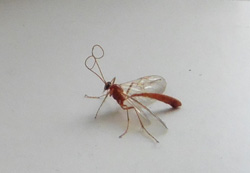 They have the most Chamber of Horrors type lifestyle. Apparently, they lay their eggs on or even inside caterpillars. The eggs then hatch and feed on the caterpillar host whilst it is still alive. Nice. Don’t visit our garden in Dorset. Please.
They have the most Chamber of Horrors type lifestyle. Apparently, they lay their eggs on or even inside caterpillars. The eggs then hatch and feed on the caterpillar host whilst it is still alive. Nice. Don’t visit our garden in Dorset. Please.
Charles Darwin knew all about them and they appear in his 'On the Origin of Species'. Talk about survival of the fittest!
Here’s are Darwin’s own words:
"to my imagination it is far more satisfactory to look at ...the larvae of ichneumonidae feeding within the live bodies of caterpillars,- not as specifically endowed or created, but as small
consequences of one general law...namely, multiply, vary, let the strongest live and the weakest die.
A Bodmin Frog and Doc Martin
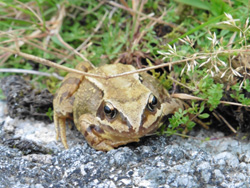 You don’t expect to come across a common frog nestling the granite foothills of a mini-mountain do you? Or maybe you do? We came across this one early one evening up at Rough Tor on Bodmin Moor. The ground was very marshy, come to think of it, so maybe it wasn’t that strange.
You don’t expect to come across a common frog nestling the granite foothills of a mini-mountain do you? Or maybe you do? We came across this one early one evening up at Rough Tor on Bodmin Moor. The ground was very marshy, come to think of it, so maybe it wasn’t that strange.
If you have never been to Rough Tor (say row to rhyme with bough) it’s well worth going.
The ancient pile of stones at the top: the Cheesewring is a sight worth seeing in itself - and walking round. If you are a fan of Doc Martin you will recognise it from the opening credits. A spectacular natural formation of weathered granite slabs, its name comes from its resemblance to old fashioned cheese presses. I was so bowled over by the whole experience; I forgot to take any photos! Next year. Definitely.
Rained Off Barbeques and the Great Big BBQ Scone: Summer Recipes
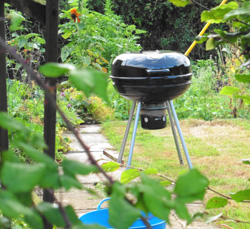 Back at home, this summer hasn’t been exactly the Barbeque summer we were hoping for. Every attempt to have a barbeque in the garden was rained off. The one time we got as far as trying to light it, the charcoal was damp – and then, to cap it all, it rained anyway!
Back at home, this summer hasn’t been exactly the Barbeque summer we were hoping for. Every attempt to have a barbeque in the garden was rained off. The one time we got as far as trying to light it, the charcoal was damp – and then, to cap it all, it rained anyway!
This massive scone was meant to be a barbeque treat but we ended up baking it in the oven. We’ve made it many times since: it makes a completely fantastic fluffy scone.
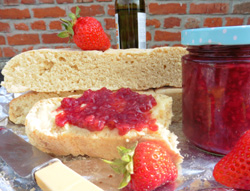 It’s extra light, partly because of the cream of tartar/bicarb combo, partly because of the minimal handling of the dough, and partly because the foil tent covering means it partially steams as well as bakes in the oven.
It’s extra light, partly because of the cream of tartar/bicarb combo, partly because of the minimal handling of the dough, and partly because the foil tent covering means it partially steams as well as bakes in the oven.
The jam in the photo is my raspberry butter: also fantastic (honestly, you must try it) -
see below for recipe.
 Loosely based on Australian ‘damper’ bread this is fun to cook on the barbeque. Eat as a savoury bread or for pudding with butter or clotted cream, jam and soft fruit.
Loosely based on Australian ‘damper’ bread this is fun to cook on the barbeque. Eat as a savoury bread or for pudding with butter or clotted cream, jam and soft fruit.
You can make the dough by hand but it’s much easier in a food processor and the resulting scone is very light.
-
400g plain flour
- 1½ teaspoons bicarbonate of soda
- 3 level teaspoons cream of tartar
- 50g salted butter (at room temperature)
- 25g sugar
-
200ml milk, ideally slightly warmed
You will need extra thick, extra wide foil
Add raising agents to weighed flour and sieve into processor bowl. Add butter and pulse into fine crumbs. Add sugar and whiz briefly to incorporate.
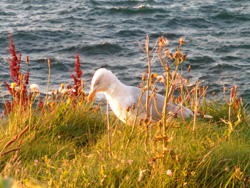 Add milk and whiz until large clumps begin to form. Transfer mix to a board, press gently together and mould into a ball. Dust lightly with flour and roll into a circle just around 1 ½ cm thick.
Add milk and whiz until large clumps begin to form. Transfer mix to a board, press gently together and mould into a ball. Dust lightly with flour and roll into a circle just around 1 ½ cm thick.
Transfer to a double thickness of buttered foil large enough to wrap around the dough in a loose package.
Score the top with lines (you’ll be able to use these as slicing guides later) and dust with flour. Gather foil edges together and wrap loosely, pleating the top.
Cook over medium hot coals for ten minutes on each side.
Alternatively, bake inside at 200C (fan ovens) or equivalent for 15-20 minutes until golden: position parcel directly on oven shelf. There’s no need to turn when you are baking it in the oven.
Raspberry Butter or Very Much Less Sugar Jam
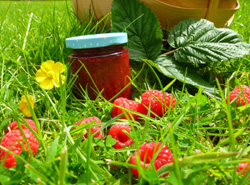 This recipe, nothing to do with actual butter, is the most deliciously concentrated and fragrant raspberry spread. Ideal if you have a glut of raspberries, it’s simple to make in a slow cooker.
This recipe, nothing to do with actual butter, is the most deliciously concentrated and fragrant raspberry spread. Ideal if you have a glut of raspberries, it’s simple to make in a slow cooker.
It’s a much less sugary spread than jam, using 25% of the fruit’s weight in sugar, rather than the traditional equal sugar to fruit ratio of jam.
Variation
Try adding the finely grated zest of ½ a lemon at the start of cooking time.
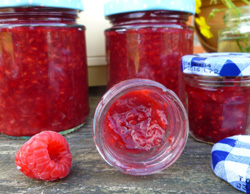 Makes 2½ x 110g jars
Makes 2½ x 110g jars
-
600g raspberries
-
150g granulated sugar
Tip raspberries into slow cooker pot. Crush lightly with a potato masher.
Add sugar and stir. Cook on high, with the lid on for 1 hour.
Stir after an hour. Angle lid across top if you have an oval cooker, or wedge open with a wooden spoon if it’s round.
Cook for 5-6 hours until thick and reduced to the consistency of apple sauce. You may like to remove lid completely for the last 2 hours. Stir from time to time.
 Spoon into hot sterilised jars.
Spoon into hot sterilised jars.
Note
As fruit butter contains far less sugar than jam and is cooked slowly rather than boiled rapidly, it’s wise to store the jars in the fridge. You can also freeze it for up to 3 months or so. Use small plastic lidded containers and fill to the brim.

 According to the legend of St Swithun; if it rains on July 15th, it will rain solidly for 40 days or, alternatively, if it’s sunny, the sun will shine for 40 days. To the best of my knowledge, although we did have rain last week, I don’t think we did on Wednesday: I meant to make a note and forgot!
According to the legend of St Swithun; if it rains on July 15th, it will rain solidly for 40 days or, alternatively, if it’s sunny, the sun will shine for 40 days. To the best of my knowledge, although we did have rain last week, I don’t think we did on Wednesday: I meant to make a note and forgot!
Bishop of Winchester in the ninth century, and possibly prior to that tutor to Alfred the Great, St Swithun left instructions before he died to be buried outside so the rain, and the feet of the poor, could pass over him.
He died in 862 and his wishes were carried out but nearly a century later, on July 15th, 971, his body was moved to a shrine inside Winchester Cathedral. Apparently, on that very day there was a violent rainstorm which continued for 40 days. It was thought that this may have been the saint giving vent to his feelings on the matter.
Famously unstuffy and generous, St Swithun was behind the building of many churches and the planting of many apple trees. 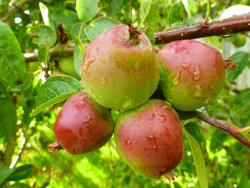 It was said when he invited people round to eat with him, he would ask the poor to be his guests rather than the rich.
It was said when he invited people round to eat with him, he would ask the poor to be his guests rather than the rich.
He also performed at least one miracle: he met a woman on a bridge with a basket of broken eggs: she had been jostled and teased by thoughtless workmen and had dropped her basket. St Swithun’s kind heart was touched and he made the eggs whole again.
There’s another legend concerning rain on this day: if it rains, it is St Swithun blessing and christening the apples - and a good harvest will follow.
Connected with this was a superstition that you shouldn’t eat apples before St Swithun’s day. Afterwards, you could pick up all the windfalls you wanted, and make jam from them.
His emblems are raindrops and apples. He should have some eggs as well!
It’s amazing to think that this legend has endured for all this years. You’d think, wouldn’t you that after all this time there would be an apple variety named after him? But I don’t think there is, I can’t find one anyway.
There is a lovely rose though, a David Austen climber/tall shrub. It sounds fantastic: soft pink, strong myrrh fragrance, full flat rosette, repeat flowering, vigorous, plenty of disease resistant grey-green foliage. I Must look out for it.
Maybe if it rains on St Swithun’s day all his namesake roses will have an extra flush of flowers.
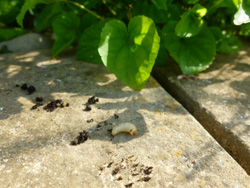 Unlike the froghopper in the last post, Vine Weevils are a serious and horribly disheartening garden pest. The adult insects are around 9mm long, a dull blackish-grey with a yellowy kind of striped and/or mottled effect. Six long legs, a pair of longish antennae and the comical looking snout, typical of weevils complete the picture. They chomp notches from the outside rims of leaves.
Unlike the froghopper in the last post, Vine Weevils are a serious and horribly disheartening garden pest. The adult insects are around 9mm long, a dull blackish-grey with a yellowy kind of striped and/or mottled effect. Six long legs, a pair of longish antennae and the comical looking snout, typical of weevils complete the picture. They chomp notches from the outside rims of leaves.
Although annoying, adult vine weevils aren’t likely to damage plants permanently but the grubs are a different story: positively evil little weevils. Creamy white (and mercifully not at all camouflaged) maggot like creatures with a tan coloured head, they curl up in a C shape.
You may find some below the surface as you dig through the soil or potting compost. They munch on the roots – often eating all the way through and severing the plant from its roots completely. Usually the plant will wilt, keel over and die. Often the first you know of it is when you see a wilted dead plant and you can just lift it up, clean away from the soil or potting compost – it’s completely detached from its roots.
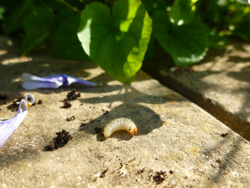 Vine weevil grub favourites tend to be: primula, polyanthus, cyclamen begonia, cacti, succulents and strawberry.
Vine weevil grub favourites tend to be: primula, polyanthus, cyclamen begonia, cacti, succulents and strawberry.
You do get vine weevils in open ground but it’s more usual to find them in pots and containers.
What to do?
The best thing is to keep on top of the situation, keep your eyes open and don’t keep re-using the same compost in containers or put a new plant into an old container where the previous occupant has died.
Have all the compost out, go through it searching for the grubs and dispose of them or leave them out for the birds (chickens love them). Use fresh potting compost for new plants. The old fully-inspected compost makes a useful mulch for the garden or add to the compost heap.
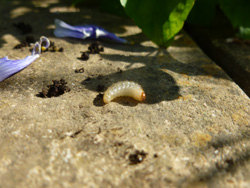 Also, every time you see an adult get rid of it. It seems harsh, especially as they look quite comical and friendly, but if you spare them they will just keep breeding. Like many garden pests, they are mainly nocturnal. Something else to look out for as you prowl the garden by torchlight on a slug hunt.
Also, every time you see an adult get rid of it. It seems harsh, especially as they look quite comical and friendly, but if you spare them they will just keep breeding. Like many garden pests, they are mainly nocturnal. Something else to look out for as you prowl the garden by torchlight on a slug hunt.
You can also trap adults with sticky barrier tape or grease.
Birds, frogs, toads, shrews, hedgehogs and carnivorous ground beetles are all keen to feed on vine weevils so encourage them where you can.
Otherwise, it’s biological control with nematodes or chemical pesticides.
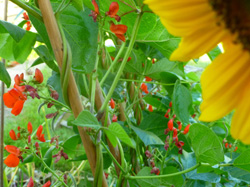 I haven’t any photos of the adult weevils or the tell-tale leaf notch nibbles at the moment, just the grubs – but I daresay I shall before the summer is very much more advanced and will post some up then.
I haven’t any photos of the adult weevils or the tell-tale leaf notch nibbles at the moment, just the grubs – but I daresay I shall before the summer is very much more advanced and will post some up then.
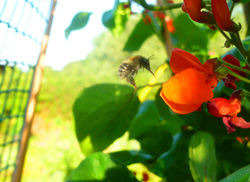 More next post, I’m a bit pressed for time as the garden needs attention, but the runner beans are doing well, despite a nasty case of blackfly. I only managed to plant one side of my bean poles with bean plants, in the end as I was bit late taking up my ruby chard. I’ve slung some plastic netting over the other side for a late crop of peas instead.
More next post, I’m a bit pressed for time as the garden needs attention, but the runner beans are doing well, despite a nasty case of blackfly. I only managed to plant one side of my bean poles with bean plants, in the end as I was bit late taking up my ruby chard. I’ve slung some plastic netting over the other side for a late crop of peas instead.
Nice to see we aren’t short of bumble bees in our part of the world.
 Sweet peas, incidentally have also been lovely. Although we seem to have neen inundated with pollen beetles. Check out the one on the sweet pea here: there are probably loads more of the little critters tucked away inside the petals as well.
Sweet peas, incidentally have also been lovely. Although we seem to have neen inundated with pollen beetles. Check out the one on the sweet pea here: there are probably loads more of the little critters tucked away inside the petals as well.
 The first lot of courgette plants are also cropping well – you know it’s summer when you can nip into the garden and harvest courgettes for your tea every night. It’s good news on the blackcurrant front too. The transplanted bush has survived and has produced plenty of ripening currants. The six cuttings I took back in March are also thriving.
The first lot of courgette plants are also cropping well – you know it’s summer when you can nip into the garden and harvest courgettes for your tea every night. It’s good news on the blackcurrant front too. The transplanted bush has survived and has produced plenty of ripening currants. The six cuttings I took back in March are also thriving.
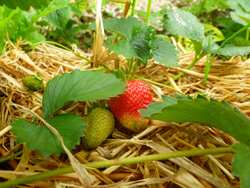 We had started to pick a few early strawberries but unfortunately, before I could net them, a deer wandered into the garden one night and ate the top off most of the plants – leaves, flowers and ripening fruit.
We had started to pick a few early strawberries but unfortunately, before I could net them, a deer wandered into the garden one night and ate the top off most of the plants – leaves, flowers and ripening fruit.
Netting and a complicated night-time assault course of upturned wheel barrow and garden hose are now in place.
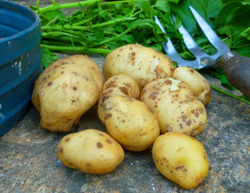 Luckily, they left the raspberries.
Luckily, they left the raspberries.
We’ve also started digging up the Arran Pilot potatoes. They have the most beautiful firm white flesh and taste wonderful. I shall be very sorry when we’ve eaten them all.
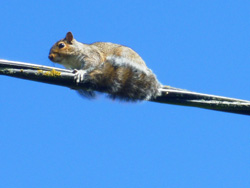 High Wire Squirrel
High Wire Squirrel
We could not believe this the other Saturday morning. Catching up with a recorded episode of Springwatch at breakfast time, I happened to glance out of the window to see our own Springwatch or more accurately Summerwatch happening outside. A grey squirrel was zipping along the nearby telegraph line. You could almost hear the Mission Impossible theme tune pounding away in the background. I dashed out and managed to get a couple of shots.
 It froze for a few moments when it saw me, with its tail wrapped tightly round the cable but then s/he was off again and pitching head first down the distant telegraph pole despite it being festooned with cables and those metal teeth to stop people climbing up. It obviously couldn’t read the ‘danger of death’ notice and ran off unharmed.
It froze for a few moments when it saw me, with its tail wrapped tightly round the cable but then s/he was off again and pitching head first down the distant telegraph pole despite it being festooned with cables and those metal teeth to stop people climbing up. It obviously couldn’t read the ‘danger of death’ notice and ran off unharmed.
Baby Spiders ‘Spiderlings’ Hatching
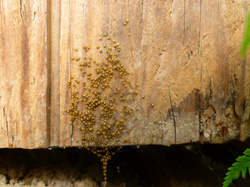 A couple of weeks ago on the shed door in the garden, there was more Springwatch-type action: a clutch of hundreds of spider eggs was hatching.
A couple of weeks ago on the shed door in the garden, there was more Springwatch-type action: a clutch of hundreds of spider eggs was hatching.
I can’t say I’m normally fond of greenfly but I did feel sorry for this one, caught on its own amongst all these hungry fly-eating infants. I didn’t stop to find out the fate of the poor creature. One minute it’s alone with a ball of random inert globules the next it’s surrounded by a seething mass of doom.
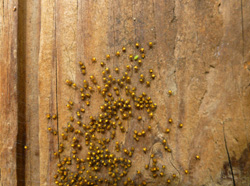 I’m pretty sure they were baby garden spiders: common araneus diadematus or cross orb weavers, which hatch around this time every year.
I’m pretty sure they were baby garden spiders: common araneus diadematus or cross orb weavers, which hatch around this time every year.
Bright yellow, they have a black blob on their backs. Their mother would have laid the eggs: all 300-800 of them last autumn. I don’t want to upset you, but if you have read the children’s story Charlotte’s Webb, or seen the film, you will know that with some varieties of spider, she then dies, having carefully covered them in thick web of protective silk to keep them warm over the winter. I'm not sure if this happens with garden spiders.
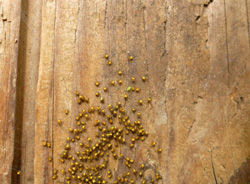 Once hatched, they stay clustered together until they are mature enough to cope alone. If disturbed, they spring away from each other, swinging on a quickly spun ‘safety harness’ rope and reassemble when the danger has passed.
Once hatched, they stay clustered together until they are mature enough to cope alone. If disturbed, they spring away from each other, swinging on a quickly spun ‘safety harness’ rope and reassemble when the danger has passed.
Starling School
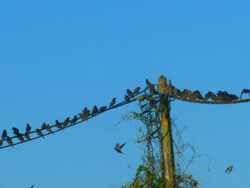 More high-wire action: we have lots of starlings around us at the moment. They have that ruffled, slightly confused look that ‘teenage’ fledglings have. Here they are assembling on the telegraph wire. I wonder if they have some ‘sensible adults’ mixed in with them?
More high-wire action: we have lots of starlings around us at the moment. They have that ruffled, slightly confused look that ‘teenage’ fledglings have. Here they are assembling on the telegraph wire. I wonder if they have some ‘sensible adults’ mixed in with them?
 For mediaeval poet Geoffrey Chaucer, May was the month when everything was at its most beautiful. For Gertrude Jekyll, famed horticulturist, garden designer, artist and writer, who was born half way through the 19th century and died in the 1930’s, it was June:
For mediaeval poet Geoffrey Chaucer, May was the month when everything was at its most beautiful. For Gertrude Jekyll, famed horticulturist, garden designer, artist and writer, who was born half way through the 19th century and died in the 1930’s, it was June:
“ . . . June, the time of perfect young summer, the fulfilment of the promise of the earlier months, and with as yet no sign to remind one that its fresh young beauty will ever fade.”
Comfortingly, the situation remains unchanged here at the beginning of the 21st century. Both months are still as gorgeous as they ever were in the garden (weather permitting, obviously).
Personally, I think of June as a kind of intensified May, with more and more plants unfolding and flowering daily.
Mind you, if you are up in Scotland, it might be worth remembering Billy Connelly’s famous comment:
“There are two seasons in Scotland: June and winter.”
Late May Bank Holiday Monday, 2015
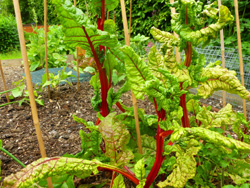 Amazingly, late May bank holiday Monday, was another glorious day. 2015 has certainly been a bumper year for fine weather bank holidays, rather than the traditional wet washouts.
Amazingly, late May bank holiday Monday, was another glorious day. 2015 has certainly been a bumper year for fine weather bank holidays, rather than the traditional wet washouts.
Again, as with Easter Monday, keen to avoid the usual traffic chaos, we stayed at home for a chill-out day, so there were lots of gardening opportunities.
I seemed to spend loads of time heaving paving slabs about but also managed to put up my bean poles. Why do you always end up squinting into a glaring hot sun, both  arms aching agonisingly above your head, whenever you try to tie the tops of bean canes together?
arms aching agonisingly above your head, whenever you try to tie the tops of bean canes together?
Despite my best care and slug pellets, some of my runner bean plants (Polestar & Moonlight, saved seeds from last year) were just a little bit holey. I’ve left the overwintered rhubarb chard, looking slightly out of control now, on one side, planted my holey beans on the other and will plant some more bean seeds once I’ve taken out the chard.
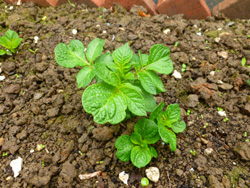 Annoyingly, my honesty seedlings (I’m really desperate for those plants to survive, especially as biennials, they will take 2 years to establish have been a bit ‘slugged’ too. I’ve put them aside for some extra sheltered care and hope they will recover.
Annoyingly, my honesty seedlings (I’m really desperate for those plants to survive, especially as biennials, they will take 2 years to establish have been a bit ‘slugged’ too. I’ve put them aside for some extra sheltered care and hope they will recover.
The first Arran Pilot potato shoots are coming through now (admittedly they were put in quite late). Must earth them up.
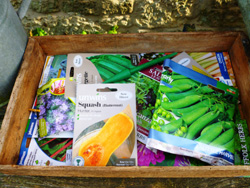 Seeds
Seeds
Also sowed seeds of: Butternut Squash ‘Hunter’, Courgette ‘Zucchini’, 2 varieties of French marigold Tagetes ‘Golden Gem’ and ‘Starfire’, Cosmos ‘Candy Stripe’ and Zinnia ‘Purple Prince.
Time to pot up/ plant out the Electric Daisies, Echalions ‘Simiane’ and Prairie Fire chillies.
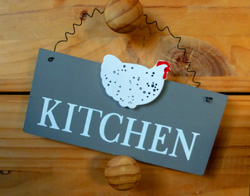 When you think about it, there are lots of similarities between cooking and gardening. The same bits and pieces are often at home in both areas:
When you think about it, there are lots of similarities between cooking and gardening. The same bits and pieces are often at home in both areas:
Recycled yoghurt pots and plastic drinks bottles have been widely used by gardeners for years: I’ve discovered big Tupperware-type containers make brilliant window ‘cold frames’. I’ve got a large sturdy 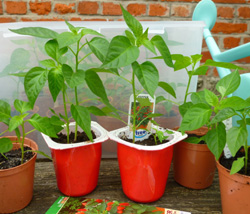 transparent plastic box we used to keep bread in until the lid broke that’s great for this. I’ve also got 2 large square plastic cake containers that are handy for rearing small pots of seeds. If you start them off on the windowsill with the lids on, when the seedlings emerge you can take the lids off.
transparent plastic box we used to keep bread in until the lid broke that’s great for this. I’ve also got 2 large square plastic cake containers that are handy for rearing small pots of seeds. If you start them off on the windowsill with the lids on, when the seedlings emerge you can take the lids off.
Mini wooden craft pegs
Those little mini wooden pegs you get from craft shops 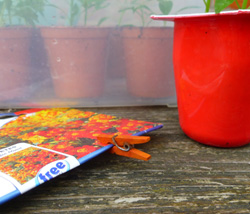 are ideal for keeping half-used seed packets closed
are ideal for keeping half-used seed packets closed
Magic sponge/eraser
‘Magic’ sponges, available for a couple of quid from hardware shops and household cleaning departments in supermarkets are terrifically useful in the garden. They are good for buffing up your secateurs and snips and for cleaning plant labels so you can use them again.
They are made from microporous melamine foam in case you’re interested. Although it’s soft and spongy to the touch, it works like extremely fine sandpaper, getting 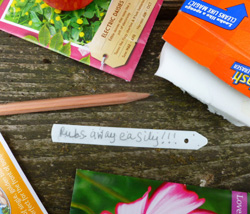 into all the tiny pits and cracks of whatever you’re cleaning. It works well slightly moistened but I’ve also used it dry. It leaves a very slight residue which rinses off easily. I clean my magic sponges in the dishwasher and eventually they do disintegrate but only after quite a lot of use. You can also cut a new sponge into smaller squares if you like.
into all the tiny pits and cracks of whatever you’re cleaning. It works well slightly moistened but I’ve also used it dry. It leaves a very slight residue which rinses off easily. I clean my magic sponges in the dishwasher and eventually they do disintegrate but only after quite a lot of use. You can also cut a new sponge into smaller squares if you like.
Limescale spray cleaner for your seed trays
The kind of limescale cleaner for kitchens and bathrooms in spray bottles is really handy to have in your potting shed: use it for cleaning seed trays and reservoir trays that are looking a bit wrecked and cloudy. Keep a few old cleaning cloths in the shed as well.
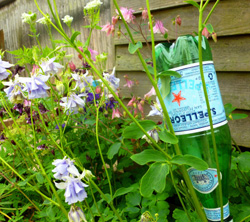 Cane Toppers
Cane Toppers
Plastic bottles are always handy for putting over canes to stop you poking your eye out and look nicely informal. Some of us have been a bit pretentious recently over our choice of plastic bottles . . . .
(although not ever so much)
Spit Bugs aka Froghopper Nymphs Philaenus spumarius
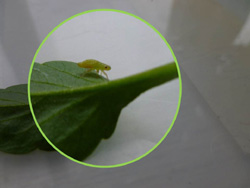 Every gardener is familiar with the little balls of froth you see on plants from April to June known as cuckoo or frog spit. Common throughout the UK, froghoppers like gardens, woodland edges and grassland.
Every gardener is familiar with the little balls of froth you see on plants from April to June known as cuckoo or frog spit. Common throughout the UK, froghoppers like gardens, woodland edges and grassland.
They aren’t really pests at all. Although a few species cause serious agricultural headaches: some of which can be found in Trinidad, feasting on sugarcane and making a general nuisance of themselves, there’s not much to worry about froghopper-wise in an English country garden.
Inside the foamy mass is a tiny comical looking, creamy coloured little creature with dark eyes. It’s a froghopper nymph. They do look a little bit like frogs, or at least a kind of tadpole and they can certainly jump. 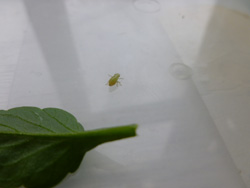 The baby bugs are strong jumpers, the adult froghoppers even more so: able to make impressive vertical jumps, jumping higher proportionally in terms of body weight than fleas, apparently.
The baby bugs are strong jumpers, the adult froghoppers even more so: able to make impressive vertical jumps, jumping higher proportionally in terms of body weight than fleas, apparently.
The froth hides the nymph from predators – and tastes nasty in case predators do strike - protects them from heat and cold and stops them drying up. The little nymphs suck sap from the leaves and stems of plants, but they are so tiny it’s not really enough to damage the plants significantly. They drink more than they need for nourishment and the undigested excess – if you really want to know - is then blown out of their back end as froth.
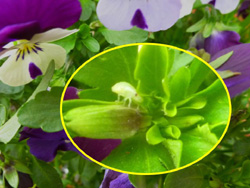 Little Phil the Froghopper
Little Phil the Froghopper
This little guy was minding his own business on a potted viola when I noticed all the ‘spit’. I scraped the froth away and manage to get a couple of photos. He looked so sweet and defenceless I carefully put him back on the same plant afterwards. He seemed perfectly all right and none the worse for his experience. Let’s hope he was able to use his back end to generate more froth.
Strawberries coming on
 Here’s a bit of our small strawberry bed. There are more strawberries in a slightly larger bed with the raspberries and a blackcurrant bush – optimistically known as the ‘Fruit Border’.
Here’s a bit of our small strawberry bed. There are more strawberries in a slightly larger bed with the raspberries and a blackcurrant bush – optimistically known as the ‘Fruit Border’.
The small bed has 3 lupins planted at the back. I wanted somewhere sheltered for the lupins - it can be a windy site - and thought why not here as companion plants for the strawberries?
Lupins belong to the legume family. This means the roots fix nitrogen in the soil, which fertilizes the ground for plants in the area – and the flowers attract pollinators such as bees and hoverflies. A well pollinated strawberry is a plump, juicy and well-formed strawberry.
Dennis, one of our 2 ginger cats, always takes a keen interest whenever I have to take any photographs of food. Even if he is nowhere near when I start setting up he usually appears within a few minutes.
Here he is the other week when I was trying to take a photograph of fried asparagus with bacon for Garden News. Yes, I did give him a little bit of bacon: I had to; he gave me that special ‘look’ of his!
Cats. What can you do, eh?
Good Egg (Saturday, June 13th 2015)
When you buy eggs, and you don’t normally notice them individually especially.
But if you keep only a few hens, you can find yourself remarking on each egg you collect: even more so if you keep a mixed flock of different breeds as it’s easy to tell who laid what by the differing colours and relative sizes.
Often with young pullets – young hens new to the game – you get quite a few extra-large eggs in their first months of laying that turn out to be double-yolkers. This happens as their systems get into the swing of things and are a real bonus for the hen keeper, eating-wise.
I certainly noticed this egg (above) when I collected it the other day: it came complete with its own ‘fascinator’!
Or sometimes you get a really large egg such as this one, pictured (top & Below) which weighed a 100g.
When you think that in commercial terms a Large egg is one that weighs 63-73g and a Very Large is 73g and over, that’s pretty good going.
It’s not a record breaker though; one was recently in the papers, weighing 163g and there are eye-wateringly much heavier eggs in the Guinness Book of records, if you care to look.
Incidentally, eggs are now sold in four different sizes: Small, Medium, Large and Very Large.
Egg Sizes
-
Very Large: 73g and over
-
Large: 63-73g
-
Medium: 53-63g
-
Small: 53g and under
As you can see, the 100 gramm-er turned out to be a double yolker.
Something else you notice about your own newly laid eggs: the yolks aren’t flat like stale shop-bought ones but round and sitting up proudly on the white. The colour is a deeper yellow as well, especially if you give your girls a little corn in the afternoon and they have fresh grass to nibble on.
Eggs-tra Bonus Recipe: One Egg Cake and Cake Tunnelling
I put the egg to good use and baked a100g cake with 100g each of
softened salted butter, golden caster sugar and flour to match the
weight of the egg. I baked it in an 18cm (7 inch) loose bottomed
sandwich tin at 160C (fan oven) for 18 minutes.
I used self-raising flour (I normally use plain and add 2 parts cream of
tartar to 1 part bicarbonate of soda) as I was in a bit of a hurry.
A
bit too much of a hurry as it turned out, as you can see from the
photo, there is a certain amount of ‘tunnelling’ in the cake’s
structure.
Tunnelling in cakes is usually a sign of too much mixing,
especially if you favour an electric mixer or processor, as I do. On
this occasion, I was a bit distracted and actually walked away from the
mix for a few moments – don’t ever do this!
Anyway,
it was a bit over-worked: this can develop the gluten (which you only want to do in bread dough, not cake mix) leading to extra
pockets of air and holes rather than the nicely fine and
even texture you are aiming for.
It can make cakes slightly tough as well rather than the desired light and tender texture.
Ideally a cake should be mixed until all the ingredients are fully
incorporated – no visible streaks of flour and so on; beautifully smooth
yet not overworked and overmixed.
I
was also slightly worried it might be a bit ‘over-egged’ as the egg was
a double yolker and the finished cake texture texture did look slightly
dense.
But in the end it was fine: instead of slicing it horizontally, I made a
‘half cake’ as you can see from the curved bottom in the
photo. I warmed about a tablespoon of raspberry jam and added almost as
much again of redcurrant jelly (I didn’t have any more jam, bit of a cod's up in the catering department) and added a
few fresh raspberries, for the filling. A dusting of vanilla icing sugar
was the finishing touch.
It
all tasted lovely and not dense or tough at all. We took it on a picnic
and ate it with some low fat Greek yoghurt that had vanilla icing sugar
stirred through. Gorgeous, like eating a really good trifle.
All the same:
it's best not to over-mix your cakes and definitely don’t walk away from the mixer !!!

Did you know, the name “spring” originally referred to the way living things “spring into life” after the cold, barren days of winter? The season when new life and hope literally springs up out of the ground was first known as the “springing time”.
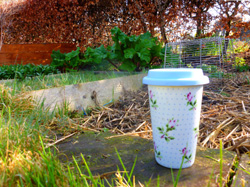 Easter Monday, 2015
Easter Monday, 2015
Easter is the traditional start to the garden season. Unusually, bank holiday Monday this year, was the most brilliant day weather wise. Thinking we would avoid the usual traffic chaos, we stayed at home so there were lots of gardening opportunities.
Early in the morning: the day stretched ahead full of gardening possibilities. There was lots to be done and by the end of it, with the help of several cups of tea,  I had made massive inroads: grass was cut, seeds were sown, weeds were dug up, a few plants given by friends when they divided perennials were planted*: including 2 cardoons, several clumps of Johnson’s Blue hardy geranium, francoa and osteospermum. Watering, pot cleaning, seaweed tonic administering, all were done. I stunned myself with my horticultural achievements. I’ve had a few productive sessions here and there since but Easter Monday was the day of the big push.
I had made massive inroads: grass was cut, seeds were sown, weeds were dug up, a few plants given by friends when they divided perennials were planted*: including 2 cardoons, several clumps of Johnson’s Blue hardy geranium, francoa and osteospermum. Watering, pot cleaning, seaweed tonic administering, all were done. I stunned myself with my horticultural achievements. I’ve had a few productive sessions here and there since but Easter Monday was the day of the big push.
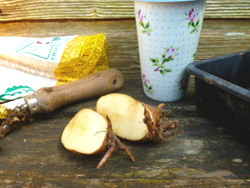 *For me this sharing of plants and seedlings is one of the pleasures of gardening, you do have to be careful though that your friend hasn’t inadvertently given you some bindweed or ground elder as well as the actual plant. Similarly, make sure you don’t give any friends an unwanted bonus.
*For me this sharing of plants and seedlings is one of the pleasures of gardening, you do have to be careful though that your friend hasn’t inadvertently given you some bindweed or ground elder as well as the actual plant. Similarly, make sure you don’t give any friends an unwanted bonus.
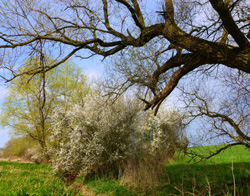
Blackthorn Blossom in April
To make up for the lack of blackthorn blossom photos in last month’s post, here is how our local blackthorn looked in mid-April.
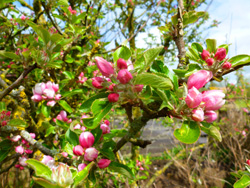 Apple Blossom Time
Apple Blossom Time
Speaking of blossom, look at our neighbour’s glorious Bramley apple trees in bloom towards the end of April.
Pest Guest: Cutworms
Although many of us feel we should respect the balance of nature, not go too mad and exterminate every poor creature that poses the slightest threat, cutworms really are a bit of a menace.
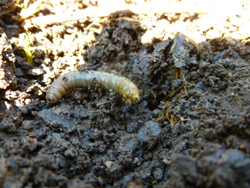 Cutworms are the caterpillars or larvae of several species of moths and spend the larval stage of their life mainly in the soil: sleeping during the day and coming up to the surface at night.
Cutworms are the caterpillars or larvae of several species of moths and spend the larval stage of their life mainly in the soil: sleeping during the day and coming up to the surface at night.
They vary slightly in appearance and can be dull brown, grey, cream, brown or pinkish, sometimes with dark lines or dots: the fact they have lots of little legs sets them apart from actual worms. The usually curl up when they are resting. 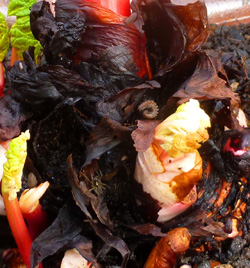 They are around 2cm long although some can be longer.
Cutworms are very active at the beginning of the gardening season. This first wave of the year is the generation that hatched from eggs laid in late summer and autumn and has overwintered in the soil or somewhere similarly dark and cosy such as a wood pile. I even found one curled up in a rhubarb crown back in February.
They are around 2cm long although some can be longer.
Cutworms are very active at the beginning of the gardening season. This first wave of the year is the generation that hatched from eggs laid in late summer and autumn and has overwintered in the soil or somewhere similarly dark and cosy such as a wood pile. I even found one curled up in a rhubarb crown back in February.
 They cause headaches for the gardener in that they wake up from their winter hibernation absolutely ravenous and get stuck in straightaway to any vegetable roots, stems, stalks and foliage. They love tubers such as seed potatoes and early carrots. After a couple of months of voracious feeding they pupate in the soil, going on to lay eggs in June and July. The actual moths, apparently, are fairly harmless, just drifting about at night and feeding on nectar: it’s the offspring that are the problem.
They cause headaches for the gardener in that they wake up from their winter hibernation absolutely ravenous and get stuck in straightaway to any vegetable roots, stems, stalks and foliage. They love tubers such as seed potatoes and early carrots. After a couple of months of voracious feeding they pupate in the soil, going on to lay eggs in June and July. The actual moths, apparently, are fairly harmless, just drifting about at night and feeding on nectar: it’s the offspring that are the problem.
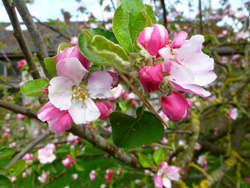 Apart from being vigilant and culling any that you see day or night, you might like to try nematodes which kill the caterpillars in the soil. You can buy the correct nematodes for cutworms online or ask at your local garden centre.
Apart from being vigilant and culling any that you see day or night, you might like to try nematodes which kill the caterpillars in the soil. You can buy the correct nematodes for cutworms online or ask at your local garden centre.
The nematodes are watered into the soil. You probably don’t want to hear the horror story of what happens when they actually meet the cutworms. Let’s just say, the nematodes sort the cutworms out so they are no longer a problem.
Let’s just say, the nematodes sort the cutworms out so they are no longer a problem.
Cat Attack
One of our cats, Dennis has taken to window hopping again now spring is here. Instead of using the perfectly good cat flap in the kitchen, he likes to be let out of the sitting 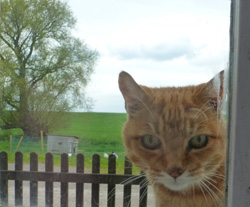 room window. He also likes to come back that way too. Often, unfortunately about 5 minutes after he’s gone out!
room window. He also likes to come back that way too. Often, unfortunately about 5 minutes after he’s gone out!
Cats. What can you do, eh?
Here he is waiting to be let in. Excuse the gently rusting garden furniture in the background.
‘In like a lamb and out like a lion’ was more like it this year. Soft and mild weather gave way to frosts and general chill, a welcome spell of glorious sunshine popped up in the middle and the month ended with lashing rain and high winds.
A blackthorn winter . . .
. . . is another well-known 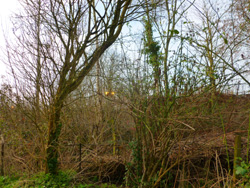 weather saying at this time of year. Once blackthorn starts to flower there is said to be an accompanying spell of cold and unsettled weather with strong easterly winds. This was more or less true this year although the cold and windy weather was interspersed with some fine and sunny days – that must have been the unsettled bit!(No photos unfortunately: all these are leading up to the solar eclipse, see below.)
weather saying at this time of year. Once blackthorn starts to flower there is said to be an accompanying spell of cold and unsettled weather with strong easterly winds. This was more or less true this year although the cold and windy weather was interspersed with some fine and sunny days – that must have been the unsettled bit!(No photos unfortunately: all these are leading up to the solar eclipse, see below.)
There are masses of blackthorn bushes planted along the carriageway that leads into our local town. I noticed whilst driving that way on the morning of March 9th there’d been a sudden massive explosion of blackthorn blossom – it was like driving through a lacy corridor!
There is quite a difference between blackthorn (or sloe) and hawthorn (or may) blossom.
Blackthorn has pure white elegant flowers with yellow stamens and flowers, which bloom, depending whereabouts in the country you are, from late winter to April, on stark, bare black branches with long slender thorns.
 Hawthorn has cheery rounded creamy-white flowers, sometimes flushed with pink. When a flower first opens, the anthers are quite big and pinky coloured. Within a day they seem to shrink and turn brown. Whichever stage they are at; they are striking and distinctive. Hawthorn blooms after the pale green leaf buds have unfurled in May: all its sharp thorns are hidden.
Hawthorn has cheery rounded creamy-white flowers, sometimes flushed with pink. When a flower first opens, the anthers are quite big and pinky coloured. Within a day they seem to shrink and turn brown. Whichever stage they are at; they are striking and distinctive. Hawthorn blooms after the pale green leaf buds have unfurled in May: all its sharp thorns are hidden.
This leads to another, often confusing country saying:
ne’er cast a clout till May is out.
This probably means: don’t assume winter is over and start packing away your winter clothes – or clouts - after a random fine spell. Be prudent and wait until the may blossom is out. 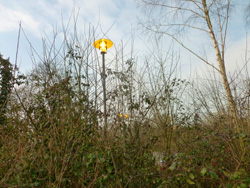 Other people may take it to mean, keep your woollies to hand until the very end of the month of May.
Other people may take it to mean, keep your woollies to hand until the very end of the month of May.
Incidentally, country people in years gone by sometimes called hawthorn the "bread and cheese tree". Apparently, the young leaves and leaf buds make a tasty snack: much appreciated by children walking to and from school along the lanes. They are meant to have a sweet and nutty flavour; eat straight from the branch or scattered over salads - flower buds too. Must try some this year – I’ll keep you posted!
In the shadow of the moon March 20th
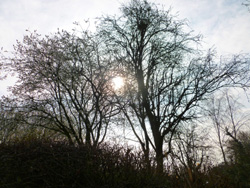 The last day of winter, or the first day of spring, depending on your point of view, March 20th brought a solar eclipse.
The last day of winter, or the first day of spring, depending on your point of view, March 20th brought a solar eclipse.
Northern Scandinavia had a complete eclipse. Down here in the south of England we had a partial one: 84 per cent of the sun was covered by the moon. It was expected to start at 8.45am, with the maximum eclipse at 9.31am and end completely at 10.41am.
Although I took some photos at precisely 9.31 by my camera, I seem to have not quite got the whole thing! It was strange to see the yellow sodium lights come on in our local 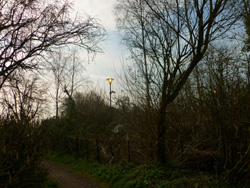 Waitrose carpark though, in what had been quite bright sunshine moments before. There was an unusual stillness and the sun looked oddly eerie through the trees.
Waitrose carpark though, in what had been quite bright sunshine moments before. There was an unusual stillness and the sun looked oddly eerie through the trees.
Moments later, the sun was shining brightly again.
Good start to the new gardening year
Back in the garden, I haven’t made a bad start at all to my gardening resolutions for this year. (See last October’s post). I managed to get quite a lot done over the middle of the month when we had some really encouraging spring-like weather.
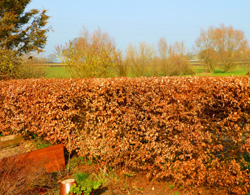 I haven’t quite dug the new dedicated salad bed yet but I have started pulling down the old tumbledown shed where the new bed will be in preparation for it. This was after cleaning and tidying the other shed and moving stuff into it from the falling down one. I have had a major clear-out but kept anything genuinely useful like my 7 faithful cloches made from office water cooler bottles with the bottom cut off. I’ve had them for years but they still work a treat.
I haven’t quite dug the new dedicated salad bed yet but I have started pulling down the old tumbledown shed where the new bed will be in preparation for it. This was after cleaning and tidying the other shed and moving stuff into it from the falling down one. I have had a major clear-out but kept anything genuinely useful like my 7 faithful cloches made from office water cooler bottles with the bottom cut off. I’ve had them for years but they still work a treat.
I have sorted out last year’s old strawberry bed: new offspring of the existing plants had razzled (to use a technical term) unchecked. This was my fault entirely and down to lack of proper time management. The plants were so overcrowded as a result the bed was largely unproductive last summer so massively disappointing and a real loss eating-wise.
Strawberries 'Ostara'
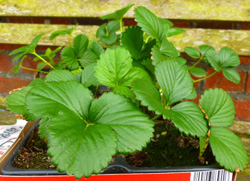 I bought some new strawberry plants as well. Our local Lidl had some tempting offers and a good selection of 4 different varieties. I chose ‘Ostara’ as it’s a perpetual strawberry: I’ve never grown perpetuals before but always wanted to. They flower and fruit all summer from June until the first frost which sounds terrific. Apparently 'Ostara' has a particularly lovely flavour with pretty cone-shaped, deep red aromatic berries. It’s also meant to be very prolific. Yes, please, I can’t wait!
I bought some new strawberry plants as well. Our local Lidl had some tempting offers and a good selection of 4 different varieties. I chose ‘Ostara’ as it’s a perpetual strawberry: I’ve never grown perpetuals before but always wanted to. They flower and fruit all summer from June until the first frost which sounds terrific. Apparently 'Ostara' has a particularly lovely flavour with pretty cone-shaped, deep red aromatic berries. It’s also meant to be very prolific. Yes, please, I can’t wait!
Raspberries
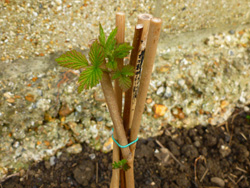 I bought 3 new raspberry plants from Lidl too the following week: ‘Schonemann’ and have planted them to supplement the single lonely cane that survived from last year. Schonemann are meant to be easy to grow and very productive – let’s hope so.
I bought 3 new raspberry plants from Lidl too the following week: ‘Schonemann’ and have planted them to supplement the single lonely cane that survived from last year. Schonemann are meant to be easy to grow and very productive – let’s hope so.
Annoyingly, last year, I bought a bundle of a promising variety, ‘Glen Doll’, from a really good garden centre but only 2 of the 5 canes ‘took’. And one of those died over the winter! Looking at the defunct raspberry labels the other day, it did stress that they should on no account be planted in ground where any other rubus family members have been. There had been a wild bramble there, admittedly, that still keeps popping up.
Honestly, unless you have a massive garden with loads of suitable sites for raspberries if you followed that advice you’d never grow any raspberries at all! The remaining cane must have been extra tough and hardy. So far the new plants are thriving so fingers crossed.
Mini Wildflower Meadow
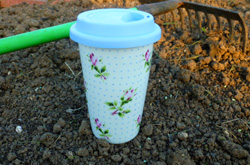 The little hawthorn tree and blackcurrant bush have now been moved from the site of the new mini meadow and replanted. The gooseberry bush was in a bit of a sad state and had to be discarded unfortunately.
The little hawthorn tree and blackcurrant bush have now been moved from the site of the new mini meadow and replanted. The gooseberry bush was in a bit of a sad state and had to be discarded unfortunately.
The blackcurrant bush has been replanted near the raspberries and strawberries and seems to be doing well. It was in need of a good prune and I even planted 6 of the healthy looking pruned shoots, which so far seem happy and healthy.
I’ve made a stale seed bed (see above and below) to get the new mini meadow off to a good start.
I’ve also cut down all the old stems from the flower border and given it a general weeding and sorting out. I still need to dig up some of the plants that have gone a bit mad and are trying to take over including the Michaelmas daisies.
Some of the seeds I’m looking forward to most this year
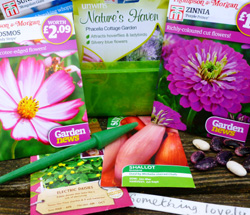 As well as sowing the usual suspects and 2 old favourites that I miss from my old garden, handily free with Garden News magazine: honesty and everlasting pea, I am branching out this year with:
As well as sowing the usual suspects and 2 old favourites that I miss from my old garden, handily free with Garden News magazine: honesty and everlasting pea, I am branching out this year with:
Echalions
I was hoping for either ‘Long Red Florence’ or ‘Figaro’ (see November’s post) but couldn’t find them at any of the seed stockists near us. Instead, I plumped for a new Sutton’s variety: ‘Simiane’ which sounds – and looks on the packet – very promising.
Electric Daisies Spilanthes acmella
I was intrigued by these when I read about them somewhere or other earlier this year – I can’t remember where - then found them in the Sutton’s catalogue. They are from James Wong’s recommended ‘Homegrown Revolution’ collection of seeds.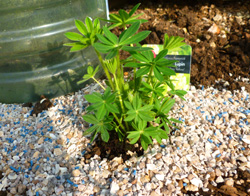 I love James Wong: he has so much knowledge of plants and their edible and medicinal uses.
I love James Wong: he has so much knowledge of plants and their edible and medicinal uses.
Anyway, these annual little edible daisies apparently taste just like a ‘jolt of electricity’! Should be interesting!
Phacelia
you’re breaking my heart . . .
Oops, sorry, quick paraphrase of an old Paul Simon song there. I grew hardy annual phacelia tanacetifolia or ‘fiddleneck’ years ago in my old garden. The lilac-blue flowers are breathtakingly beautiful to look at and very attractive to hoverflies and ladybirds. It’s quite hard to find standard packets of the seeds now – although you can buy them quite easily in bumper-size green manure packets. They are a great green manure plant, supressing weeds and re-introducing nutrients into the soil but are so pretty it seems a crime to cut them down, literally in their prime, before 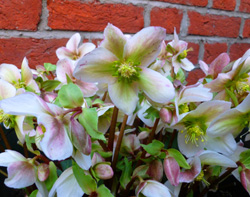 they flower and have a chance to attract beneficial insects.
they flower and have a chance to attract beneficial insects.
Sunflower ‘Mongolian Giant’ (hugely tall) sunflower ‘Velvet Queen (a modest 5 feet tall with deep red petals) cosmos ‘Candy Stripe’ (my favourite cosmos which for some reason I haven’t grown for a few years) and zinnia ‘Purple Prince’ ( I have never grown zinnia before – so many plants, so little time and space - and am really looking forward to these which I hope will all come out true to the gorgeous pinky purple shade on the packet) all happily also free with Garden News.
A Stale Seed Bed
 I have always meant to make one of these and the start of March is the ideal time. Sowing can then take place at the beginning of April
I have always meant to make one of these and the start of March is the ideal time. Sowing can then take place at the beginning of April
A stale seed bed is really an old farming technique for ridding the ground of weeds. Basically, ground is cleared of deep rooted perennial weeds and any annuals that have already grown, raked to a fine tilth and then left undisturbed for a few weeks.
It works because seeds only germinate within the first 5cm depth of soil. Any weed seeds deeper than that don’t receive sufficient light to spark them into action. It’s the light levels in spring that are the trigger for dormant seeds to wake up and grow.
Anything lurking below the 5cm mark should stay dormant.  It’s important not to disturb the ground - and any dormant seeds - halfway through this stale bed technique as then you’ll have to start back at the beginning.
It’s important not to disturb the ground - and any dormant seeds - halfway through this stale bed technique as then you’ll have to start back at the beginning.
Once the weed seeds have germinated and are about an inch high you can hoe them gently away – again don’t dig down into the soil to any depth and disturb more seeds. I might pull them up carefully by hand as it’s such a small area.
Signs of Spring
MU Posy
Here’s the posy I received from the Mothering Sunday service at our local church this year. 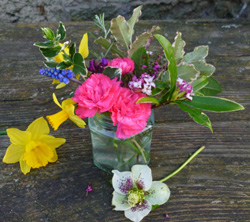 The Mothers’ Union make them up using what’s available from their own gardens every year. They all have fantastic gardens which are always strong on winter flowering and scented shrubs. The viburnum (middle right of posy) smelt wonderful – must plant some in our garden. I was very taken with the blotched hellebore too: I must look out for a similar variety.
The Mothers’ Union make them up using what’s available from their own gardens every year. They all have fantastic gardens which are always strong on winter flowering and scented shrubs. The viburnum (middle right of posy) smelt wonderful – must plant some in our garden. I was very taken with the blotched hellebore too: I must look out for a similar variety.
Further up (sorry, photos a bit out of sync this month) are a couple of the hellebores we have already. Both are in pots near the kitchen door. 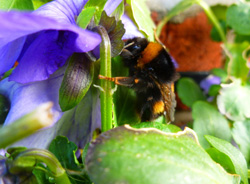 I removed all the old leaves so we could see the flowers properly. It’s worth floating single flowers in a bowl: they look terrific and last for several days. Even quite tight buds you have knocked or pruned off by mistake will open out.
I removed all the old leaves so we could see the flowers properly. It’s worth floating single flowers in a bowl: they look terrific and last for several days. Even quite tight buds you have knocked or pruned off by mistake will open out.
Queen Bee
This bumble bee queen (above) came out of hibernation on the morning of March 10th
She spent a little while waking up on a pansy 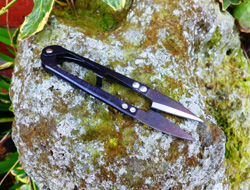 just outside our kitchen door and was gone by afternoon.
just outside our kitchen door and was gone by afternoon.
Useful Snips
Speaking of pruning: these were a much appreciated Christmas present and are actually very handy!
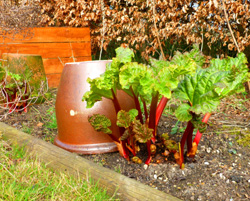 Rhubarb
Rhubarb
Our 2 crowns of rhubarb (variety ‘Strawberry’)are looking very promising. I’m still checking them obsessively at every stage as I’ve been doing all winter.
One of those March days that sort of shimmers
March the 18th was a fantastic day: one of those late winter-early spring days that sort of shimmers (see photo at start of: 'Back in the garden'). I managed to steal several hours in the garden between work deadlines and got a satisfying amount done: including planting one of my 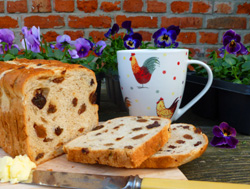 Mothers’ Day presents: a blue, a lemon and 2 pink Russell hybrid lupins.
Mothers’ Day presents: a blue, a lemon and 2 pink Russell hybrid lupins.
Later on I had a cup of tea before planting out some dainty little violas in pots and troughs. These new ‘hot cross bun loaves’ are really nice – must have a go at making one. Thrilled to bits with my new mug: it was beginning to feel a lot like Easter.
Muscular Bottomed Mad March Hare
I love hares: it’s always magical seeing them. Unbelievably (see small blur just to left of centre, below) this one suddenly appeared in the field opposite our house mid-afternoon on Sunday March 22nd.  We’ve never seen hares here before: perhaps it got lost! We’ve not seen it since despite scouring the fields anxiously for several days afterwards desperate for another sighting. Well at least we saw it the once. I don’t think I’ve ever been so close to a wild hare before and couldn’t get over its very muscular bottom!
We’ve never seen hares here before: perhaps it got lost! We’ve not seen it since despite scouring the fields anxiously for several days afterwards desperate for another sighting. Well at least we saw it the once. I don’t think I’ve ever been so close to a wild hare before and couldn’t get over its very muscular bottom!

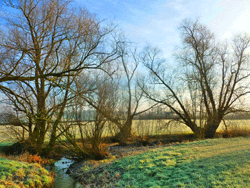 There’s an old saying: ‘Jan and Feb, lowest ebb’ which sums up nicely the miserable flat feeling you often get at this time of year.
There’s an old saying: ‘Jan and Feb, lowest ebb’ which sums up nicely the miserable flat feeling you often get at this time of year.
Early mornings and late afternoons are cold and dark, and the garden is usually either too wet and muddy or frozen solid to get much done. It’s a time of watching and waiting garden-wise.
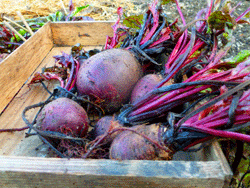 Our vegetable plot is very prone to waterlogging through the winter and this year is no exception.
Our vegetable plot is very prone to waterlogging through the winter and this year is no exception.
Beetroot
Despite this, I managed to harvest a decent crop of beetroot from the ‘Beet Box’ mid-month: enough to make a batch of red velvet brownies (absolutely lovely, keep an eye on the cooking blog; I’ll post the recipe soon).  I’ve probably pulled only around one fifth or even one sixth of the crop, so there’s still plenty more to go at for some roasted beetroot for Sunday lunch or more brownies.
I’ve probably pulled only around one fifth or even one sixth of the crop, so there’s still plenty more to go at for some roasted beetroot for Sunday lunch or more brownies.
This box idea, like a mini-raised bed, has been well worth doing and certainly worth doing again throughout the season.
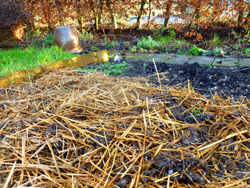 Henhouse mulch
Henhouse mulch
I’m still pressing on with the mulch of used straw on the small vegetable bed every time I clean out the henhouse. Once I’ve finished mulching this area, I’ll move onto the large bed on the opposite side of the garden.
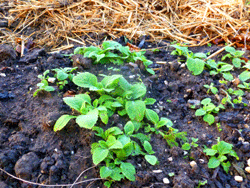 Foxglove nursery
Foxglove nursery
There’s a small area of the bed I shall leave clear of mulch as an encouraging group of self-sown foxglove seedlings has sprung up. Foxgloves are always welcome: it can be difficult to get them established in a new garden and I’m only too pleased to take as many as possible.
We didn’t get our St Martin’s summer after all. A spookily sultry Halloween was abruptly elbowed out of the way by heavy frosts, torrential rain and high winds.
Frosty Sunrise

This is how it was on the morning of November 6th starting with a glorious sunrise. The protracted spell of mild weather has been lovely but in a way it’s good to feel properly wintry at last.
Frosty Fields
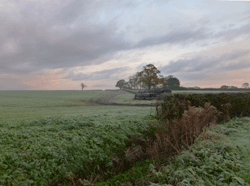
The fields around our house looked a picture: here is the picture!
Frosted Borage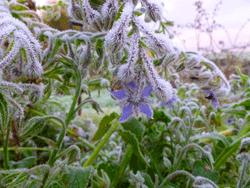
I still can’t get over the borage this year: talk about good value, how gorgeous is this? It was so late in arriving; maybe that’s why it’s lasted so long. I planted some seeds in one area in late May/June, thinking we weren’t going to have any otherwise, and suddenly self-sown seeds from last year seemed to pop up all over the place.
End of the Beans
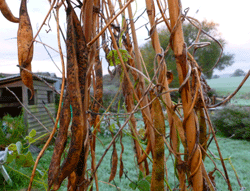
This really is the end of the beans: I had stopped picking them a while back anyway, as they had got that bit too tough and stringy to be a pleasure to eat: I collected a few to save as seed and called it a day. They look quite good like this though, defiant to the last.
Rising Brook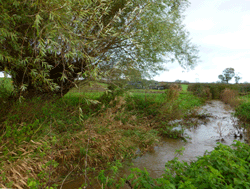
Within the space of 7 days, we had a late heatwave, heavy frosts and here it looks as though flooding is on the way. That’s the British weather for you! Typical! This is the brook across from our house looking swollen.
Despite the weather there are still some flowery treasures to be found around the garden in November.
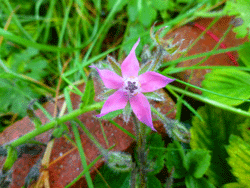
Fading to Pink Borage
|

Frosted Calendula
|

Perky Dwarf Calendula
|
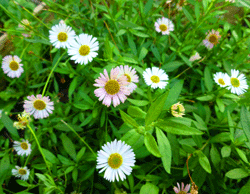
Erigeron Karvinskianus
|
Next year’s resolutions:
Must grow echalions:
Allium cepa var. aggregatum or French red shallot ‘echalote traditionnelle’
As well as sticking to all my resolutions in the last post I am absolutely definitely growing some echalions from seed next year.
I’ve recently discovered echalions, or banana shallots, as they are known – even though they aren’t anything like bananas or even true shallots but a cross between a shallot and an onion. I've been buying them from supermarkets: it would be great if I could grow them myself successfully.
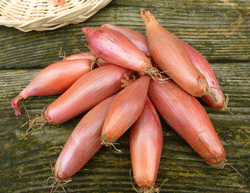
Echalions have the most beautiful sweet and mellow shallot-like flavour, not as ‘in your face’ as an onion, and the extra big bonus is they are so easy to peel. I really can’t understand why I haven’t noticed them properly before. Once peeled, you can slice them in half vertically or slice them cylindrically: very quick and simple in stark contrast to true shallots!
For years (although not this year) when it came to planting onion and shallot sets, I would say: I’m definitely not doing shallots this year; they are far too fiddly to peel. Every year, I would give way at the last moment, plant a bagful and then, come harvest-time, have the time-consuming nightmare of peeling and preparation.
I’m going to go for either Long Red Florence or Figaro, I think.
According to King’s Seeds catalogue Long Red Florence ‘is a traditional torpedo shaped red onion from Italy, producing good size bulbs with deep purple-red colour’.
Whereas Figaro ‘produces attractive, shiny, copper brown-skinned bulbs with crisp white flesh and a very distinct flavour’ according to Thompson & Morgan.
(Above are some I bought earlier . . . .)
Gone are the days when we can linger on the patio, as we did throughout the long summer: although I do sometimes lurk by the back door with a cup of tea. Never mind, there is still some colour and interest and a nice bit of productivity going on.
Cyclamen Triumph
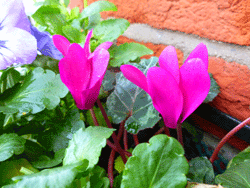
The purple and lilac pansies and violas in pots around the door are looking good and I’ve had a bit of a surprise triumph in the half basket on the wall: a bright pink cyclamen from last Christmas has flowered for the second year. It’s one I either bought or was given in a pot last winter, intended for indoors over the holiday, probably a semi-hardy cyclamen persicum.
Cyclamen never thrive for long indoors, it’s too hot for them. I think I only kept this one indoors for a couple of days before planting it in this sheltered wall basket. It flowered beautifully for ages, and now it’s back again. I’ve never kept this type of cyclamen alive for more than a few weeks before.
Mini Chillies 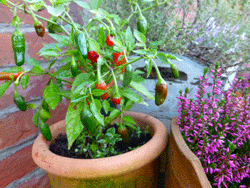
3 Prairie Fire chilli plants and one Apache are still covered with fiery hot mini-chillies: they are in in sheltered positions by the house wall, but I ought to move them indoors if I want to keep them through the winter again.
Miniature chillies are so useful: 3-4 are terrific for a chilli con carne for 4 people and they freeze beautifully for cooking. Put them straight into freezer bags and use from frozen: just snip straight into the dish with kitchen scissors.
Two Salad Stars
Two salad leaf stalwarts are still producing: buckler leaf sorrel rumex scutatus and claytonia, claytonia perfoliata, also known as spring beauty, miner's lettuce or winter purslane.

The small shield shaped leaves of buckler leaf sorrel are piercingly lemony and very refreshing: just a few leaves perk up a salad no end. You can grow it like an annual although it is a perennial. If grown as a perennial, it can get a bit invasive on the plot, seeding and running everywhere, so it does need keeping in check.
Claytonia is a cool season, annual crop and pops up everywhere. It tastes absolutely gorgeous, fresh and mild and the slightly thick leaves are apparently full of vitamin C: in the past it's been eaten to ward off scurvy. 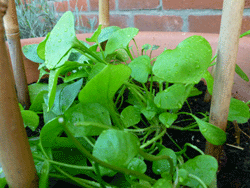 It’s the kind of salady bit that young children don’t object to as well: always a bonus!
It’s the kind of salady bit that young children don’t object to as well: always a bonus!
Anyway, the buckler leaf sorrel is still growing in a trough and a fresh crop of claytonia has very handily jumped in and filled the big ex-sweet pea pot all by itself – probably encouraged by the residual nitrogen. There’s some baby ruby chard as well in another trough, but I know from experience, the leaves will be too tough for salads by now. The plants can go out in the plot next year.
Not before Thyme . . .
 This year for the first time ever, I have got quite a few welcome thyme seedlings gate-crashing pots on the patio. I use a lot of thyme and plants get woody quickly so I shall nurture all of these carefully for next year.
This year for the first time ever, I have got quite a few welcome thyme seedlings gate-crashing pots on the patio. I use a lot of thyme and plants get woody quickly so I shall nurture all of these carefully for next year.
Potted Olive
We’ve had this olive tree in a pot (see below) for years and years. It lives by the back door, soaking up the sun in summer and treating the house wall like a radiator in winter. It has a fleece cover tied round it during the very coldest spells.
We have occasionally had a little spray or two of baby olives on it but they have never come to anything before. I was amazed to see this one lone olive, almost full size, on November 3rd. As you can see, it was green with a faint pinky blush. I was even more amazed on November 15th to see it purple all over! Maybe we could try curing and brining it . . . .
Did you know a spell of fine weather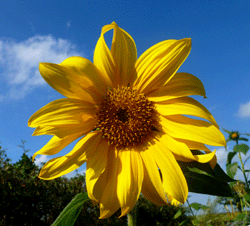 late into October used to be called a St Luke’s summer? It’s named after St Luke’s feast day on October 18th.
late into October used to be called a St Luke’s summer? It’s named after St Luke’s feast day on October 18th.
These days we tend to speak of an Indian summer, the reason why isn’t absolutely clear, although it may be because American Indians harvested their crops later in the year than the American settlers.
Anyway, whatever it’s called, we are definitely having one of them this year.
If the fine weather holds until November 11th, then we’ll be having a St Martin’s summer as well.
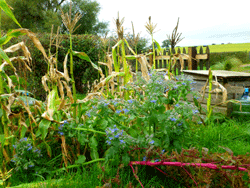 The gorgeous sunflower above graced our vegetable plot during the last week of September. Or was it the beginning of October? That glorious time, anyway, between the 2 months in early autumn or ‘Octember’, as an old friend is fond of calling it.
The gorgeous sunflower above graced our vegetable plot during the last week of September. Or was it the beginning of October? That glorious time, anyway, between the 2 months in early autumn or ‘Octember’, as an old friend is fond of calling it.
Bit of a change a couple of weeks later: here’s the same part of the plot after the so called ‘equinoctial gales’ have virtually flattened it for this year. There are often strong winds around the time of the autumn equinox when day and night length are equal, but apparently they are not actually connected to the equinox itself, as such.
The vegetable plot may be storm-ravaged but still looks striking. The borage, late bloomer to the scene this year, is a much appreciated touch of colour – and still miraculously upright. More welcome colour from the red orach even though it’s now horizontal.
The long warm summer has been ideal for pumpkins: they are larger than usual this year, according to reports. Here's our last little one: the bigger ones have all been harvested.
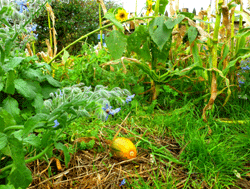
I don’t remember growing this variety: ‘Jack-o’-Lantern’ before, but definitely will again. It’s described as producing ‘round to oblong fruits’ and it’s nice to have the different shapes. These certainly did well: they were only sown in pots on the patio in June and planted out in July. Amazingly, all 10 seeds (from a free packet that had lain forgotten in the cupboard for a couple of years) germinated: result!
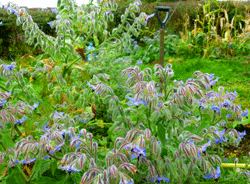
Bless that borage - it’s taken over. We don’t mind, it’s so lovely. Did you know it’s also called starflower? It’s meant to be the herb of ‘cheerfulness’ and once you’ve got it in your garden it never goes away. You’re telling me! It seeds everywhere!
We used to have some gooseberry bushes in this little bed (above) but the constant and depressing battle with sawfly caterpillars got on top of me in the end and they had to go: it was just too much of a strain!
As with so much during the growing season: slugs, greenfly, rootfly and so on and so forth, if you forget to check for 2 days on the trot: it’s absolute carnage when you return.
Having a rethink for next year: maybe a mini wildflower ‘meadow-ette’ would be nice in the old gooseberry bed? ‘Something to put in your eye and look at’ as the old country saying goes.
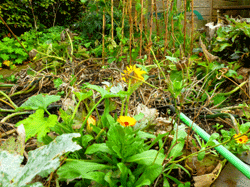 You wouldn’t think it now but we’ve had masses of lovely green courgettes with the most beautiful creamy texture and flavour from this bed. The yellow ones didn’t do as well: far fewer fruits and most of them were strangely mis-shapen. It’s a shame as the 2 colours look so pretty and appetising on the plate together when you serve them.
You wouldn’t think it now but we’ve had masses of lovely green courgettes with the most beautiful creamy texture and flavour from this bed. The yellow ones didn’t do as well: far fewer fruits and most of them were strangely mis-shapen. It’s a shame as the 2 colours look so pretty and appetising on the plate together when you serve them.
The runner beans weren’t bad either but more careful watering would have made them more succulent: some were slightly tough, it has to be said. The pot marigolds put on a good show all summer and the late planted sunflowers didn’t do too badly either.
The rhubarb wasn’t bad at all this year, all things considered: both of our 2 crowns of the bright pink ‘Strawberry’ variety had fought their way gamely through two long water-logged winters. We’ve still got some tucked away in the freezer for winter pies and crumbles.
Unfortunately, this year, it was disaster in the strawberry bed. It had ‘razzled’ completely out of control with new plantlets everywhere. I didn’t sort it out in time (my own fault entirely) so everything was too overcrowded to produce properly. Honestly, what’s the point of a garden in summer without strawberries? I shan't make that mistake again!
Almost as unfortunately, the new raspberry canes: ‘Glen Ample’ (if only they had been!) weren’t a raging success either. Hope the ones that ‘took’ will do better next year.
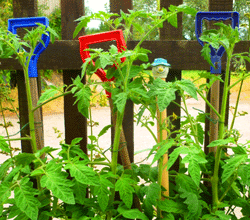

Must get some more to supplement them: although possibly not ‘Glen Ample’.
And speaking of complete and unexpected failures, the tomatoes were unbelievably struck
down with blight in August. Despite being nurtured in fresh compost in pots and fussed over outside the kitchen door, instead of out on the plot - expressly to avoid the blight - it struck.
The small select crop (3 x ‘Gardener’s Delight’ which we grow every year, and 2 x ‘Marmande’ which we’ve never grown before and I doubt will ever grow again) was completely wrecked! I could have cried. Tomatoes fresh and warm from the plant are another essential taste of summer in the garden.
Even as late as the end of October, there are still some flowery treasures to be found around the garden.
Kaffir Lily Schizostylis coccinea'Pink Princess' (fully open, early afternoon
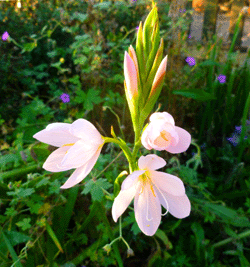
Kaffir Lily Schizostylis coccinea'Pink Princess' (closing up, early evening)
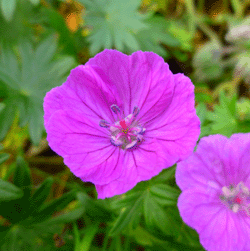
Geranium ‘Rozanne’
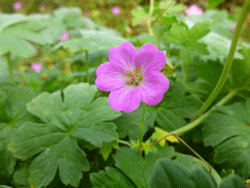
Geranium ‘Mavis Simpson’

Calendula officinialis (self-seeded very likely a descendent of ‘Indian Prince’)
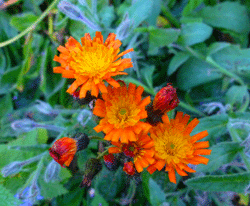
Pilosella aurantiaca (orange hawkweed or ‘Fox & Cubs’)
Next year’s resolutions:
-
More salad leaves (will dig new dedicated bed)
- Focus on strawberries and raspberries
- Sow mini-wildflower meadow in old gooseberry bed
- Keep flower border under control: especially Michaelmas daisies and Mavis Simpson geraniums
-
General all round improvement . . . .